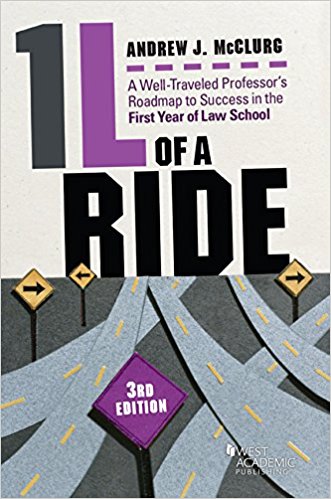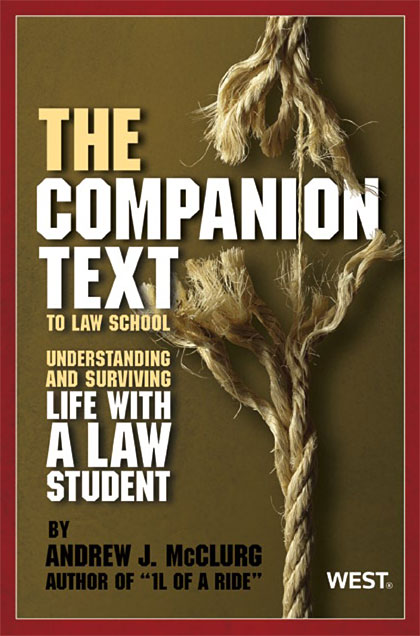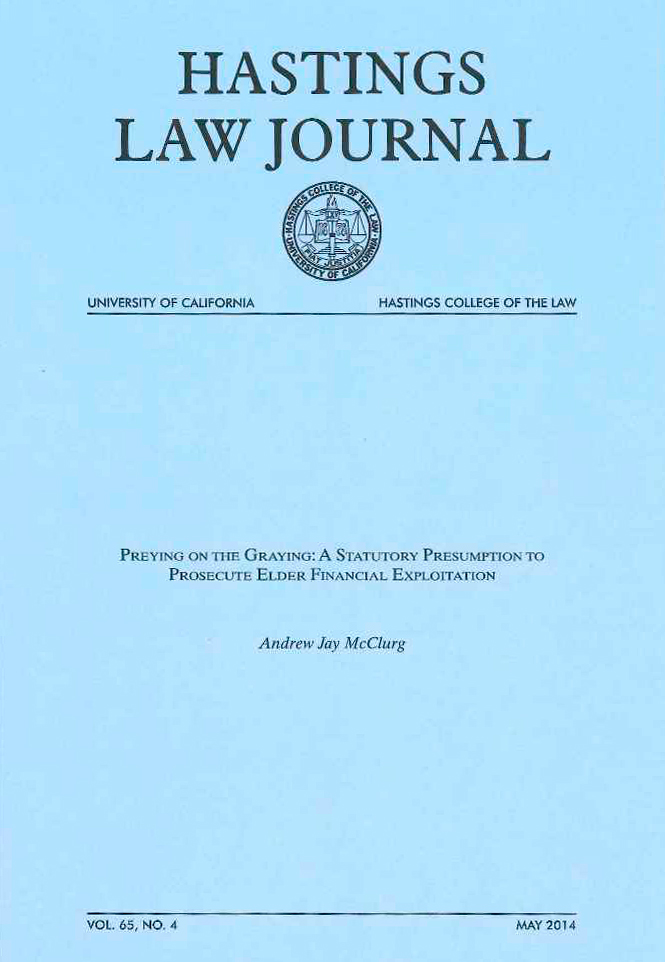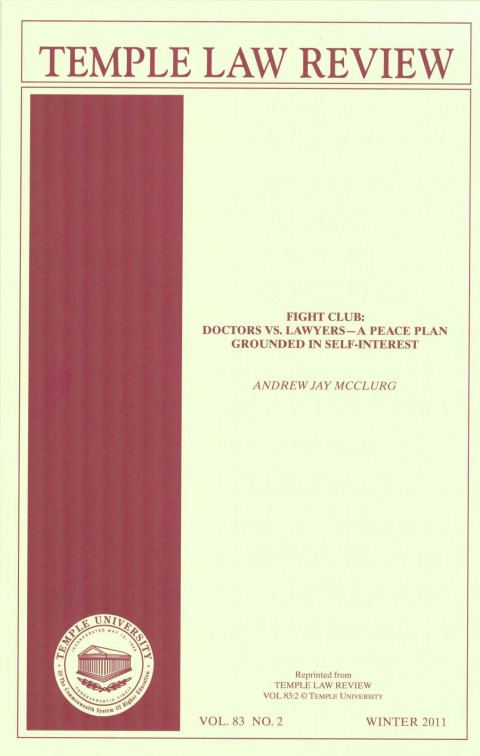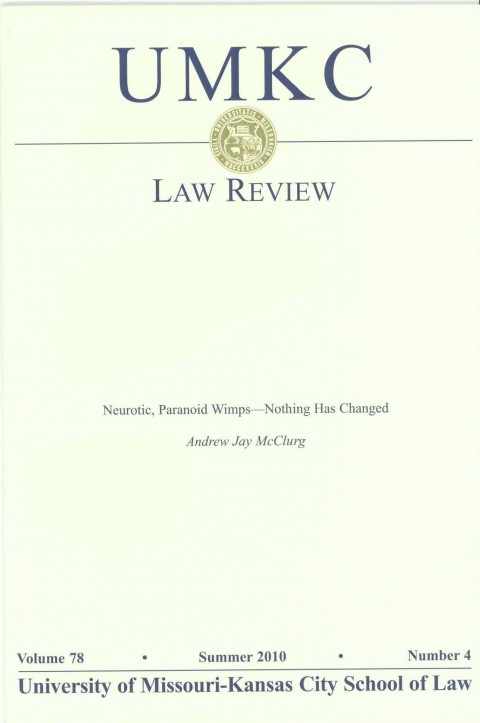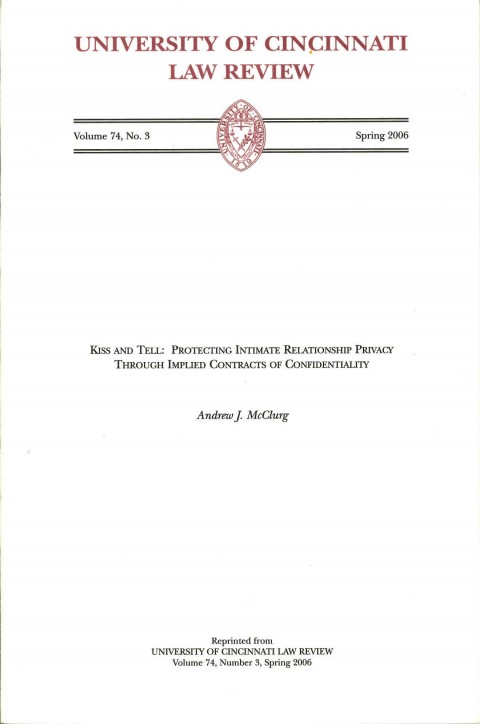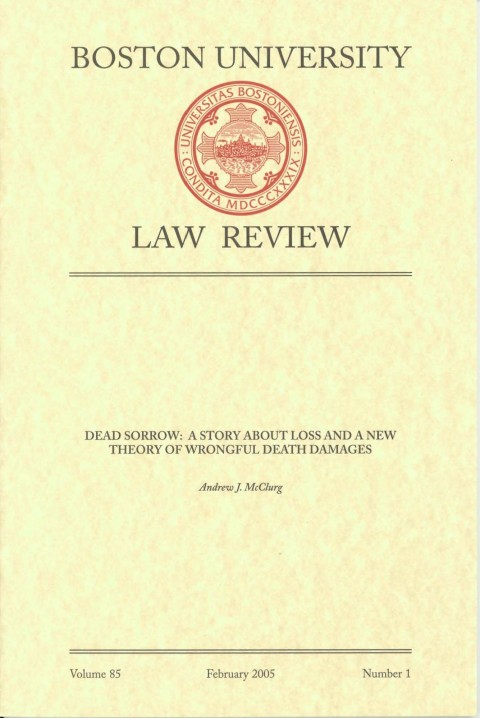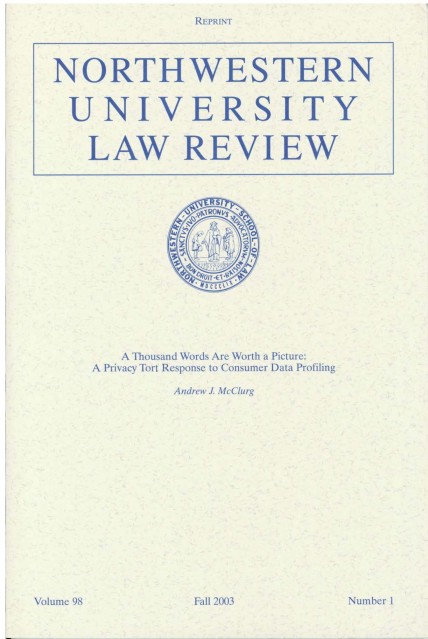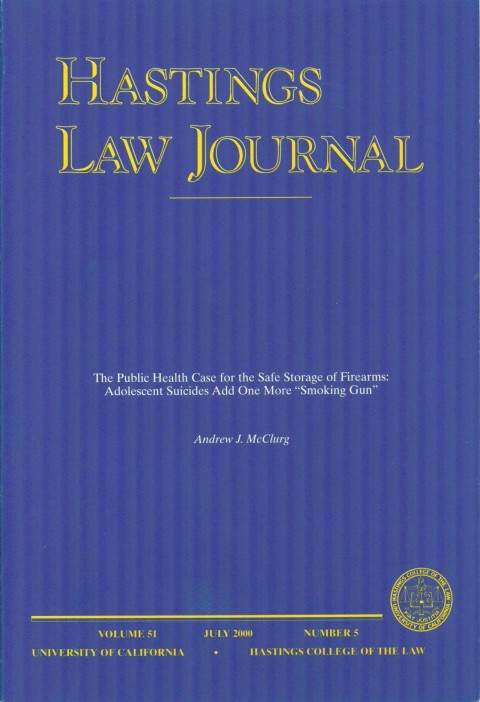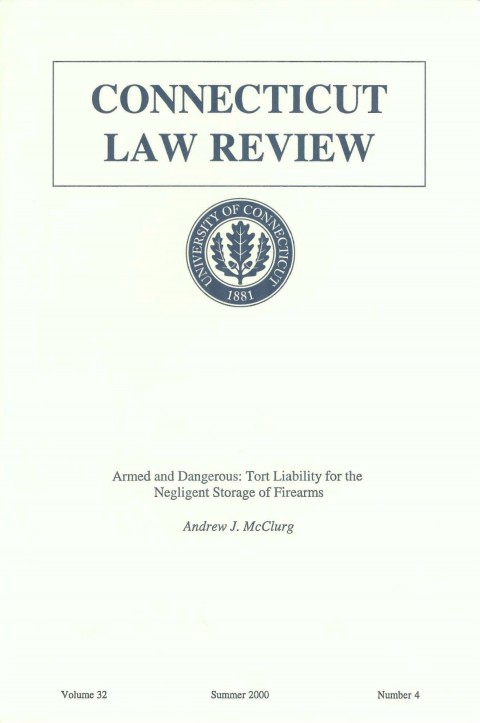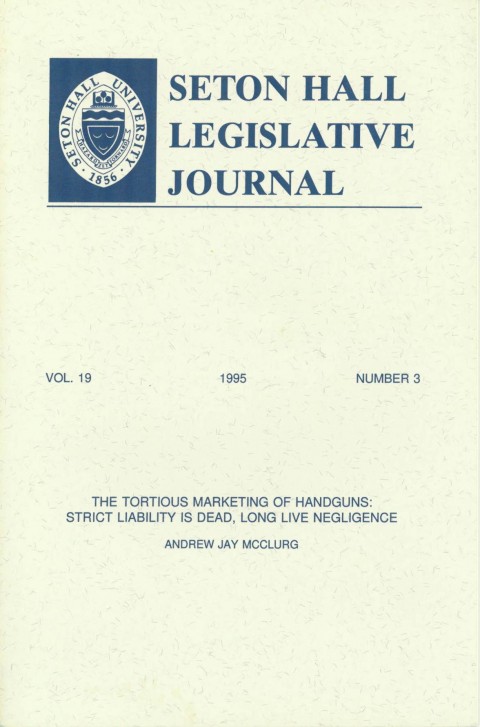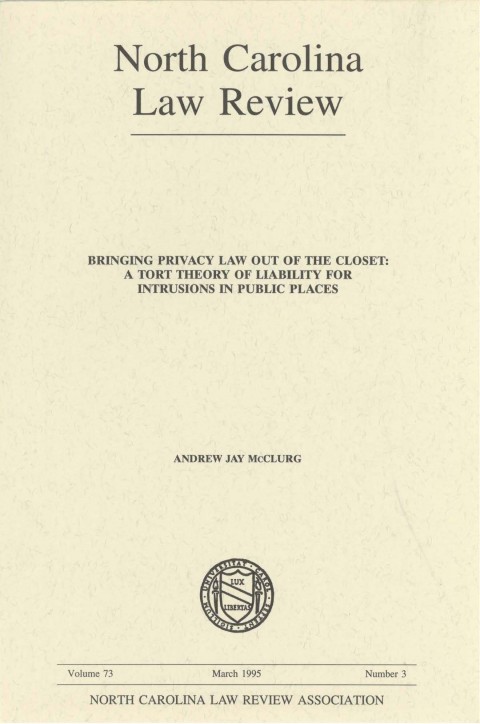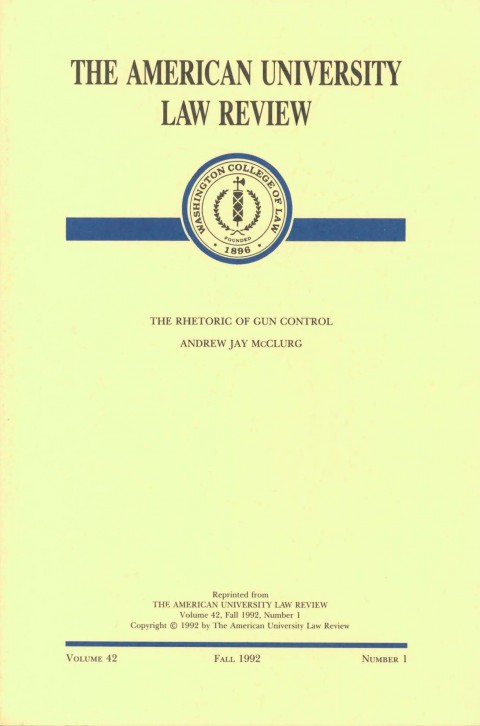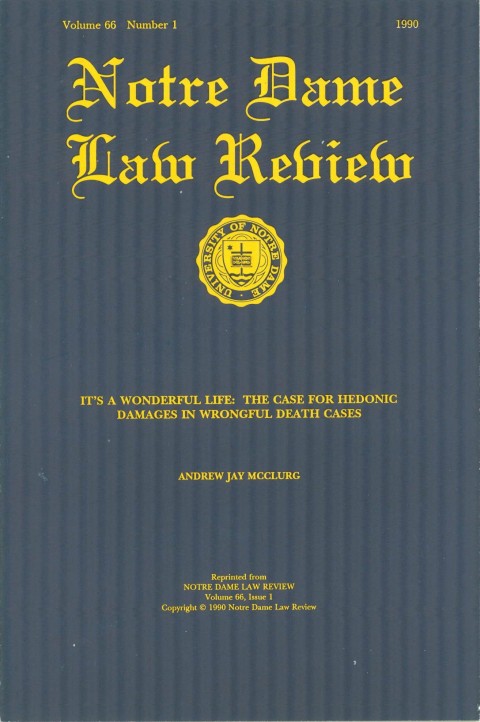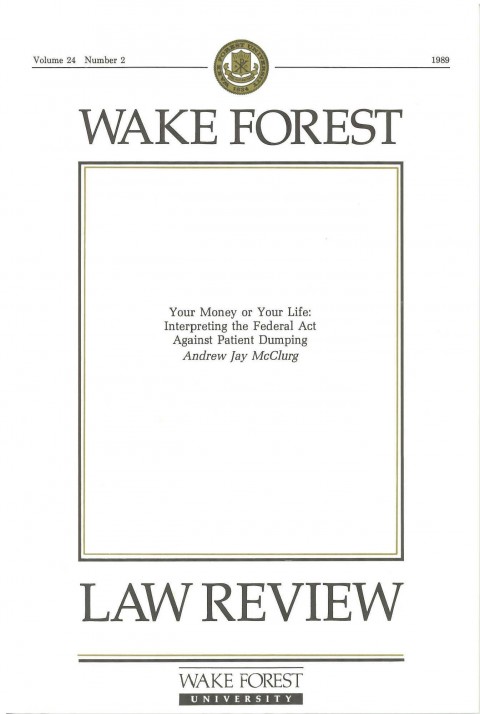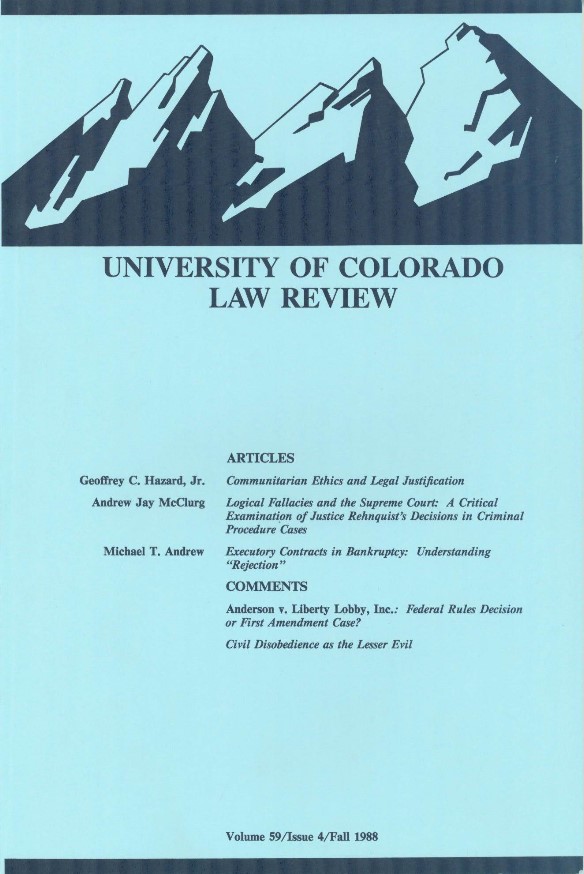October 8th, 2012  Are you in law school? Do you consider yourself to be a dedicated law student? Not sure? Measure yourself on McClurg’s simple 0-100 scale, with 0 being “I’m not totally thrilled with Judge Learned Hand” and 100 being “I aspire to be like the guy in this picture.” Are you in law school? Do you consider yourself to be a dedicated law student? Not sure? Measure yourself on McClurg’s simple 0-100 scale, with 0 being “I’m not totally thrilled with Judge Learned Hand” and 100 being “I aspire to be like the guy in this picture.”
Years ago, a student of mine at the University of Arkansas at Little Rock School of Law took a trip, to Philadelphia, I think. He struck up a conversation with a tattoo artist in a bar. When the artist learned he was in law school, she asked, “Have you ever heard of a judge named Learned Hand?” “Of course!” the student replied. All law students know and remember Judge Learned Hand.
The artist said the young man above came into her tattoo parlor with the accompanying picture of Judge Hand (the picture is from the famous Prosser, Wade & Schwartz Torts casebook used at 124 law schools) and asked to have Judge Hand, wearing a jester cap, tattooed on his arm. As proof, she followed up and sent this photograph to my student, who entrusted it to me.
For non-legals, Judge Hand was a famous judge who in a famous case–U.S. v. Carroll Towing–set forth a famous algebraic economic cost-benefit formula for determining whether injury-causing conduct was reasonable or unreasonable. If reasonable, the defendant is off the hook. If unreasonable, the defendant is liable for negligence and must pay damages. The formula is B < P x L. B stands for the burden of avoiding a risk of harm, P is the probability that the risk will actually cause harm, and L stands for the severity of the harm if it occurs. The formula states that if the burden of avoiding the harm is less than the probability of the harm occurring multiplied by the severity of the potential harm, the conduct is unreasonable (i.e., negligent). Conversely, if the burden of avoiding the risk outweighs the probability times the severity of harm, the conduct is reasonable (i.e., non-negligent).
The back of the picture is stamped with “Tattoo & Photo by Sherry Sears, Creative Images, Des Moines, IA.” So if you want to impress your professors and university’s counseling department, book a ticket to Des Moines.
October 8th, 2012  2012 “Spot the Tort” Contest with my 1Ls at the University of Memphis law school: 2012 “Spot the Tort” Contest with my 1Ls at the University of Memphis law school:
I am not sure if this is a tort, but I do know the neighborhood kids thought it was a playground! — Jessica Wargo
October 8th, 2012  2012 “Spot the Tort” Contest with my 1Ls at the University of Memphis law school: 2012 “Spot the Tort” Contest with my 1Ls at the University of Memphis law school:
This truck was completely stopped and stuck on the curb, which is why I had a chance to take the picture. The quality is not the best, but the brake lights are not only broken they are smashed out. Also, nothing in the bed of the trailer is strapped down!
I was waiting for one of the plastic poles on the side to roll off. Then I noticed that the construction machine was not tied down. Then at this point I was wondering how much damage this would do if it came off the trailer. Gravity does not work miracles! — Jessica Wargo
October 8th, 2012  2012 “Spot the Tort” Contest with my 1Ls at the University of Memphis law school: 2012 “Spot the Tort” Contest with my 1Ls at the University of Memphis law school:
My mom took a great picture for the contest! As you can see, someone lost their favorite pet chicken, and he just happened to wander out to Gus’s Fried Chicken in Collierville. Now Gus is all about saving money and the price of chicken these days is just so high … sounds like an exam question right? Trespass to chattels? Conversion? — Stewart Hornor
October 8th, 2012 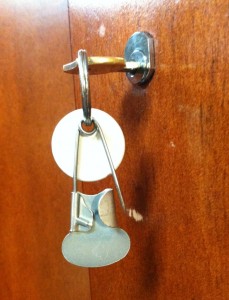 2012 “Spot the Tort” Contest with my 1Ls at the University of Memphis law school: 2012 “Spot the Tort” Contest with my 1Ls at the University of Memphis law school:
This is a photo of a potential tort I spotted at the gym this weekend. The negligence of failing to close this safety pin on a locker key could result in someone losing an eye or receiving an unwanted piercing. — Sheerin Mehdian
McClurg footnote: I would go further and argue this is a defective design for a locker room key ring.
October 7th, 2012  2012 “Spot the Tort” Contest with my 1Ls at the University of Memphis law school: 2012 “Spot the Tort” Contest with my 1Ls at the University of Memphis law school:
The size of this restroom compared to the size of its vanity in a mom and pop restaurant in my hometown of Savannah, TN, appears to me to create a danger for people who enter the restroom without paying careful attention or to those needing to get out quickly in case of a fire. — Terry VanEaton
October 7th, 2012  2012 “Spot the Tort” Contest with my 1Ls at the University of Memphis law school: 2012 “Spot the Tort” Contest with my 1Ls at the University of Memphis law school:
Forget Palin’s Bridge to Nowhere; here’s my neighbor’s Door to Nowhere. I haven’t been able to find out why it’s there–except to tempt small children to try to fly. — Natalie Worlow
October 6th, 2012 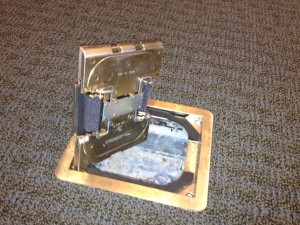 2012 “Spot the Tort” Contest with my 1Ls at the University of Memphis law school: 2012 “Spot the Tort” Contest with my 1Ls at the University of Memphis law school:
Stubbed my toe and about busted on the carpet in the 4th floor reading room of the law school because of this thing.
Now that we’re done with the memo, I’m hoping to get out this weekend to spot more torts. There will be a lot of Aggies in town for the Ole Miss game. To quote Top Gun, it’ll be a “target rich environment.” — Rob Clapper
October 6th, 2012 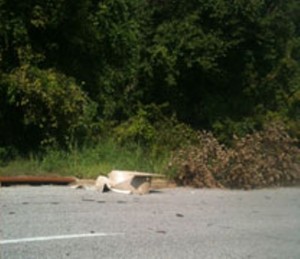 Bathtub in road hidden behind tree limb. 2012 “Spot the Tort” Contest with my 1Ls at the University of Memphis law school:
Here are a couple of (admittedly bad and small) photos of a partially fallen tree in the west bound lane of Stage-Delano Road [in Shelby County]. Hidden from the view of west bound motorist by the fallen tree, a danger in itself, was a fiberglass bathtub. The tub is visible to east bound motorists and is shown in the east bound photo. It was in the road for at least two weeks.
 View from other direction. Over that course of time, I noticed that the tub appeared to have been struck at least twice. I do not know if it was struck by a passing motorist. I can attest that damage to the tub increased at least twice over the course of my observations as I passed to and from the law school over the two weeks.
I am happy to report that it appears that the right of way on the street was mowed today and the tree and tub were removed. — Terry VanEaton
October 6th, 2012 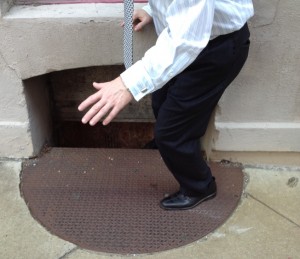 2012 “Spot the Tort” Contest with my 1Ls at the University of Memphis law school: 2012 “Spot the Tort” Contest with my 1Ls at the University of Memphis law school:
Potential tort spotted at the corner of Front and Gayoso [in downtown Memphis]. I nearly lost a Shelby County Public Defender. — Melissa Harris
October 6th, 2012  2012 “Spot the Tort” Contest with my 1Ls at the University of Memphis law school: 2012 “Spot the Tort” Contest with my 1Ls at the University of Memphis law school:
This is the outside staircase I use each and every day at my apartment. It scares the living daylights out of me. It’s hard to tell from the pic, but the poles holding it up are leaning to the right. I like to think of it as the rusted out Leaning Staircase of Memphis. Sort of like the Leaning Tower of Pisa, only much more terrifying. — Natalie Worlow
September 29th, 2012  2012 “Spot the Tort” Contest with my 1Ls at the University of Memphis law school: 2012 “Spot the Tort” Contest with my 1Ls at the University of Memphis law school:
Here’s a pic of the column holding up the front of my apartment building — resting on a few random bricks. Take my word for it that there’s no mortar between those bricks or anything physically connecting the column to said bricks. I’ll send you a pic of the outside staircase tomorrow–it scares me! — Natalie Worlow
September 29th, 2012  2012 “Spot the Tort” Contest with my 1Ls at the University of Memphis law school: 2012 “Spot the Tort” Contest with my 1Ls at the University of Memphis law school:
Just before school started the city public works department came to my house to replace a clay sewer pipe under the street. I took these photos a few minutes ago. I wonder how many more times I need to call them; I’m sure they could use the orange cone elsewhere! — Rick McCabe
September 29th, 2012  2012 “Spot the Tort” Contest with my 1Ls at the University of Memphis law school: 2012 “Spot the Tort” Contest with my 1Ls at the University of Memphis law school:
Possible tort spotted this morning on Walnut Grove in front of Baptist East Hospital. The picture is a bit blurry, but the pool table in the back of this tailgate-less truck was secured to the truck bed by nothing other than gravity. The truck also did not have functional brake lights, as we were all at a complete stop at the red light when I took the photo. — Melissa Harris
September 21st, 2012  “I am just a nowhere man, falling into nowhere land, stepping through the balcony doors to nowhere.” “I am just a nowhere man, falling into nowhere land, stepping through the balcony doors to nowhere.”
With apologies to the Beatles, that’s the tune that came to mind on receiving this picture of a second floor balcony with nowhere to go but down at a resort at Pickwick Lake in Tennessee.
The submitter said the doors open inward. While the railing no doubt helps, the open space at the bottom is still a tort waiting to happen.
August 26th, 2012  From a University of Memphis law student comes this photo of a treacherous, spiral staircase that looks like it would be a perfect set piece for a low-budget version of a Harry Potter movie. The student said the whole staircase, not just the railing, “wobbles all the way down.” From a University of Memphis law student comes this photo of a treacherous, spiral staircase that looks like it would be a perfect set piece for a low-budget version of a Harry Potter movie. The student said the whole staircase, not just the railing, “wobbles all the way down.”
Spooky. And dangerous.
Seriously. Stairs, like ladders and any other place a person can fall from height, can be extremely perilous. One recent study found that 931,886 children under five were treated in emergency rooms for stair-related injuries from 1999 through 2008, averaging 93,189 injuries per year.
Speaking of Hogwarts Torts …
July 24th, 2012  One of my colleagues was amused and bemused by this warning sticker inside the shower stall of her hotel room during a vacation to Norway: One of my colleagues was amused and bemused by this warning sticker inside the shower stall of her hotel room during a vacation to Norway:
Warning.
The bathtub can be slippery. Anti-slip mats are available at our housekeeper.
Please dial 7000.
Hmm, if the bathtubs are slippery, shouldn’t they already have mats in them? And isn’t it a bit too late to be dialing up the housekeeper for a mat once you’re already in the bath?
July 10th, 2012  Courtesy of a rising 2L at the University of Memphis law school, we have another failed attempt at conveying warnings and instructions via pictorial symbols. Courtesy of a rising 2L at the University of Memphis law school, we have another failed attempt at conveying warnings and instructions via pictorial symbols.
In evaluating pictorial warnings, remember that the principal purpose of pictorial warnings is to convey warnings to people who can’t read or read in a different language. If people could read the warnings, we wouldn’t need the pictures.
Thus, interpreting only the pictures, here’s what a non-English speaking park visitor might take away from these four frames of a sign warning about how to handle mountain lion attacks:
1. Top left: “After lion has bitten off your right hand, run AWAY from the lion. Follow the arrow. Never run toward a mountain lion.”
2. Top right: “Once you realize you can’t outrun a mountain lion and are handless, say the hell with it and give up.”
3. Bottom left: “If accompanied by children, offer them to the lion.”
4. Bottom right: “Don’t know. Can’t read it. That’s why I needed the pictures!”
June 30th, 2012 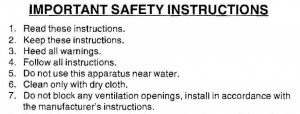 When manufacturers overwarn, it dilutes the impact of warnings that consumers really need to know about. Over-warning is a serious problem — not to be confused with global-warming, which is also really bad. When manufacturers overwarn, it dilutes the impact of warnings that consumers really need to know about. Over-warning is a serious problem — not to be confused with global-warming, which is also really bad.
Given some of the silly and dangerous ways consumers misuse products, one can have sympathy for manufacturers that don’t want to take chances. I’ve done consulting work writing product warnings and instructions for manufacturers and confess that I advise erring on the side of giving too many warnings.
But to waste space and, more importantly, short consumer attention span on worthless warnings that lead with telling consumers to:
1. Read these instructions.
2. Keep these instructions.
3. Heed all warnings.
4. Follow all instructions
… is just stupid. The most important warnings should come first. Even diligent consumers are going to tune out quickly reading these warnings (which led to the headline, a reversal of the famous line from Jerry McGuire, “You had me at hello”). No manufacturer has been or ever will be held liable for failing to warn consumers to read and keep their warnings and instructions.
Meanwhile, the list of warnings for this apparently incredibly dangerous alarm clock went on much longer, but I cut it off.
June 21st, 2012 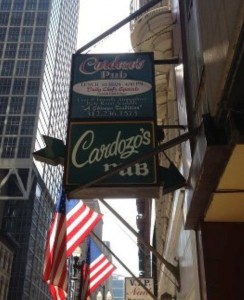 Two drink minimum; No packages wrapped in newspaper. A student of mine posted this pic on Facebook of “Cardozo’s Pub” in Chicago. Is “Andrews’ Billiard Hall” next door by any chance?
For non-legals, Judge Benjamin Cardozo is one of the most famous American jurists. He authored several judicial opinions read by law students, including the majority opinion in Palsgraf v. Long Island Railroad. Judge William Andrews wrote a famous dissent in the same case.
Palsgraf, studied by every first-year law student, is the improbable tale of a set of scales allegedly knocked on top of the plaintiff, Mrs. Helen Palsgraf, as a result of an explosion that occurred when a man running to catch a train dropped a package of fireworks while being helped onto the train by railroad employees.
For the completely true fake inside story behind these opinions, check out Palsgraf Uncovered). Other posts related to the famous case are here, here, and here.
No known connection exists between this Chicago pub and the real Judge Cardozo.
June 13th, 2012  A Facebook friend posted this picture of a candy wrapper, featuring the warning: A Facebook friend posted this picture of a candy wrapper, featuring the warning:
MAY CONTAIN TRACES OF PEANUTS AND HUMAN FLESH
Not sure where he got it or if it’s real. It doesn’t look Photoshopped (but it’s hard to tell sometimes).
Human tissue does sometimes end up in food products during the manufacturing process, probably more often than we would want to know.
My favorite “flesh in food” cases is a 94-year-old Mississippi Supreme Court case where the plaintiff found a human toe in a plug of chewing tobacco. That’s one way to “kick” the habit. Har, har.
The plaintiff couldn’t prove how the toe got there, so he invoked res ipsa loquitur. For non-legals, res ipsa loquitur is a procedural device that allows a tort plaintiff to get his case to a jury despite a lack of specific evidence that the defendant was negligent if: (1) the injury-causing event is of a nature that ordinarily would not happen unless someone was negligent; and (2) the defendant had control of the instrumentality at the time the negligence most likely occurred.
I have always loved the Mississippi court’s terse analysis of the first element: “We can imagine no reason why, with ordinary care, human toes could not be left out of chewing tobacco, and if toes are found in chewing tobacco, it seems to us that somebody has been very careless.” Pillars v. R.J. Reynolds, 78 So. 365 (1918).
But is human flesh getting into food really such an extensive problem that manufactuters feel obligated to warn about it? This is either a fishy warning or our food supply and worker safety programs are in worse shape than believed. Or, a third possibility is that California passed a law.
May 31st, 2012  When paint is not enough, add a warning cone, but do not, under any circumstances, consider actually repairing the dangerous condition. Good news! Well, kind of, sort of. Visitors might recall the treacherous sidewalk abyss adjacent to a busy Memphis street that I regularly walk on. The first attempted fix was to spray orange paint around the edge.
But maybe someone broke their leg despite that aggressive risk-reducing measure, because now the city has a new fix: an orange cone! Cement apparently is still not being considered.
But, oops, we also have a new problem a couple yards farther down: a curb stone in the middle of the sidewalk.
May 13th, 2012 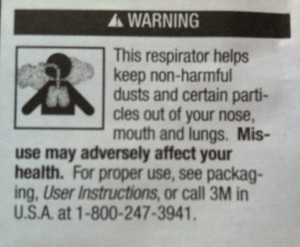 The goal in crafting a pictorial product warning is to come up with a picture that can be universally understood, even by people who speak different languages or are illiterate. But it’s darned difficult to capture most warnings in the form of a simple drawing. The goal in crafting a pictorial product warning is to come up with a picture that can be universally understood, even by people who speak different languages or are illiterate. But it’s darned difficult to capture most warnings in the form of a simple drawing.
Case in point: this warning on a 3M paint-fumes mask. You’ve seen or used these before. They are paper masks held to one’s face with rubber bands that go behind the head.
But what is this pictorial warning trying to say? The accompanying text helps, but, again, the whole idea of pictorial warnings is that they are supposed to be understandable even by people who can’t read the written warning.
So just concentrate on the picture itself and ask, “What is it saying?
Here are possibilities that come to mind:
— “Smoking Area”
— “Help, My Lungs Recently Exploded”
— “Totally Awesome Bong”
— “Short Pants Are Caused By Clouds”
And what’s up with the limitation in the written warning that the respirator helps keep “non-harmful dusts and certain particles out of your nose, mouth and lungs”? Isn’t the whole point of buying them to keep out harmful dust and particles?
May 11th, 2012  When Marc Cohn sang, “Walkin’ in Memphis, walkin’ with my feet ten feet off of Beale,” he may have been giving risk avoidance advice. When Marc Cohn sang, “Walkin’ in Memphis, walkin’ with my feet ten feet off of Beale,” he may have been giving risk avoidance advice.
Good old Memphis, a streets-and-sidewalks tort mecca.
 These photos were taken a couple blocks from Beale Street in downtown Memphis. These photos were taken a couple blocks from Beale Street in downtown Memphis.
Walk a hundred steps, spot a tort. Walk another hundred steps, spot a tort. And so on.
May 4th, 2012 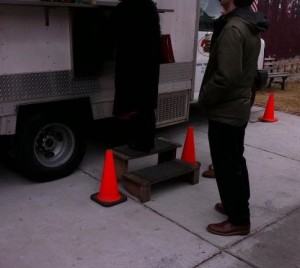 A student snapped this photo of a food vending truck in Memphis, where a customer is perched precariously on some portable steps placing an order. The steps should be both longer and wider for stability and to avoid missteps and missed steps. On the other hand, give the vendor credit for the safety cones. A student snapped this photo of a food vending truck in Memphis, where a customer is perched precariously on some portable steps placing an order. The steps should be both longer and wider for stability and to avoid missteps and missed steps. On the other hand, give the vendor credit for the safety cones.
April 14th, 2012  iTunes software is good stuff for downloading the latest crappola that the recording industry is outputting (editorial comment courtesy of a music lover still stuck in the 60s and 70s), but just remember that iTunes software is: iTunes software is good stuff for downloading the latest crappola that the recording industry is outputting (editorial comment courtesy of a music lover still stuck in the 60s and 70s), but just remember that iTunes software is:
[N]ot intended for use in the operation of nuclear facilities, aircraft navigation or communication systems, air traffic control systems, life support machines or other equipment in which the failure of the Apple software system could lead to death, personal injury, or severe physical or environmental damage.
April 13th, 2012  Here’s an interesting warning, from a former student at Florida International University College of Law. Here’s an interesting warning, from a former student at Florida International University College of Law.
The warning is on the outside of a toilet compartment on a recreational boat. I think I know what it means, but surely they could have worded it better.
March 19th, 2012
 Law student and boyfriend holding hands on romantic date night reading product warning labels at Walmart. Covering products liability in Torts and made a point of explaining what utter fun reading product warning labels can be, saying:
“In fact, if you’re looking for a really great night out, take your date to Walmart. Hold hands and spend the evening strolling the aisles reading product warning labels. It’s a guaranteed good time!”
One student and her boyfriend took me up on the idea. She sent along this great PowerPoint presentation of their romantic Walmart Product Warning Label Date.
March 9th, 2012 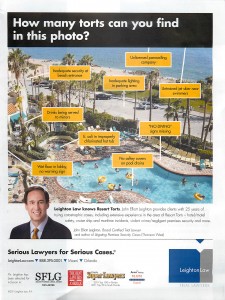 Dang, should have trademarked, “Spot the Tort,” the family friendly game of risk reduction. A former student at the Florida International University College of Law sent along this amusing law firm advertisement. (Click to expand.) Dang, should have trademarked, “Spot the Tort,” the family friendly game of risk reduction. A former student at the Florida International University College of Law sent along this amusing law firm advertisement. (Click to expand.)
March 3rd, 2012 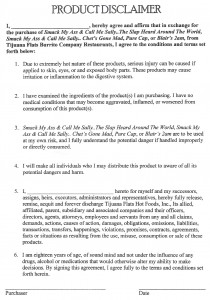 What kind of a consumer would voluntarily ingest a hot sauce so dangerous they must first sign a disclaimer/waiver acknowledging “serious injury can be caused if applied to skin, eyes or and exposed body parts,” and waiving their legal rights in the event of injury, while also certifying they are not under the influence of drugs or alcohol at the time of signing? (Click on thumbnail to expand.) What kind of a consumer would voluntarily ingest a hot sauce so dangerous they must first sign a disclaimer/waiver acknowledging “serious injury can be caused if applied to skin, eyes or and exposed body parts,” and waiving their legal rights in the event of injury, while also certifying they are not under the influence of drugs or alcohol at the time of signing? (Click on thumbnail to expand.)
Answer: The only answers coming readily to mind are an unreasonable consumer or one with an asbestos-lined stomach. If this product–a hot sauce manufactured by a burrito company and called, among other names, Smack My Ass and Call Me Sally–is dangerous enough to require a disclaimer before consumption, should it be marketed at all?
The sauce is reportedly 700 times hotter than tobasco sauce and 300 times hotter than a jalapeno. Looking forward to trying it before my next emergency colon surgery.
But believe it or not, there are much hotter sauces available! The heat of hot sauces is measured in Scoville units. Smack My Ass and Call Me Sally rates at 1.5 million Scoville units. The hottest sauce, according to a site that tracks these things, is Blair’s 16 Million Reserve, which rates 16 million Scoville units, or 3200 times hotter than a jalapeno.
Is there any other consumable product for which buyers must sign a disclaimer/waiver?
The waiver of rights may or may not be valid depending on the accuracy of the risk information in the disclaimer. If hot sauces of this nature were determined to be “unreasonably dangerous,” the waiver would not be upheld. Every product carries a warranty of merchantability that the product is fit for the ordinary purposes for which such products are used; here, human consumption.
But since several different brands of super-hot sauces exist, maybe they really aren’t dangerous. Maybe the disclaimer is even part of a marketing plan, since boasting the hottest of hot sauces appears to be a selling point.
February 18th, 2012  A first-year University of Memphis law student sent along this picture from the parking garage where most students park. The picture came as a follow-up to our class discussion in Torts II of the use of exculpatory clauses by, among others, parking garages. A first-year University of Memphis law student sent along this picture from the parking garage where most students park. The picture came as a follow-up to our class discussion in Torts II of the use of exculpatory clauses by, among others, parking garages.
Exculpatory clauses–which invariably appear on the back of tickets customers receive when they enter a parking garage–operate to relieve negligent actors of liability. Exculpatory clauses generally will be upheld if clearly written, so long as they do not pertain to an essential public service, such as medical care or education. Courts are split on whether parking garages qualify as essential public service within this rule.
Here the student pointed to two large holes in the concrete on one of the upper-levels where someone has attached, with small fasteners, thin sheets of metal as covers (that’s light shining from the floor below). She noted that “part of the one hole is still exposed where someone’s foot could fall through,” but said it made her even more nervous to think that large cars were depending on the thin sheets for support.
February 7th, 2012  A former student sent along the complaint below, which a friend of his suggested might be “the new Palsgraf for our generation.” Hmm, this might not be a good generational sign given the allegations. A former student sent along the complaint below, which a friend of his suggested might be “the new Palsgraf for our generation.” Hmm, this might not be a good generational sign given the allegations.
For non-legals, Palsgraf v. Long Island Railroad is a famous tort law case all law students read involving a bizarre accident at a train station, where the court ruled that a tort defendant owes a legal duty to act with reasonable care to another only if the other is a reasonably foreseeable victim of the defendant’s conduct. More Lawhaha.com posts involving Palsgraf are here, here, here, and here.
A national Greek fraternity, Alpha Tau Omega, apparently held a “house party” at their frat house at a West Virginia university. The complaint alleges that many of the participants consumed intoxicating beverages. No surprise so far. But one of the guests surprised at least one person (the plaintiff, allegedly) when he decided to light up–literally–the party by shooting bottle rockets from … er, I’d rather let the Complaint explain it:
Warning: Allegations are Disgusting
8. Defendant Hughes was highly intoxicated on this date and time, and decided in his drunken stupor that it would be a good idea to shoot bottle rockets out of his anus on the ATO deck, located on the back of the ATO house.
9. Upon information and belief, there were several other ATO fraternity members on the deck at the time of this incident, including one or more officers of the fraternity. Plaintiff and his girlfriend were also present on the ATO deck.
10. Defendant Hughes placed a bottle rocket in his anus, ignited the fuse, but instead of launching, the bottle rocket blew up in Defendant’s rectum, and this startled plaintiff and caused him to jump back, at which time he fell off of the ATO deck, and he became lodged between the deck and an air conditioner unit adjacent to the deck.
11. There was no railing on said deck at the time of the incident. Upon information and belief, the lack of a railing had existed for at least several months, if not years, before the incident. Upon further information and belief, the deck never had a railing when it was installed, or any time thereafter. The subject deck was approximately 3-4 feet high.
12. The subject deck was in the exclusive custody, maintenance and control of the ATO fraternity at all times relevant hereto.
Here’s your Palsgraf test: Was the plaintiff within the zone of foreseeable danger of the bottle rocket-defendant’s alleged conduct? Probably, although perhaps with some contributory negligence thrown in. Assuming the plaintiff was standing close by he could have been injured in any number of ways from someone setting off fireworks in such a dangerous, uncontrolled manner.
The more interesting question is the fraterity’s liability. Was it foreseeable to the fraternity that an intoxicated fraternity member would ignite fireworks in such a bizarre manner and cause a startled bystander to fall off the deck? Probably not, but it is foreseeable that during social or other gatherings on a deck with no railing (which the complaint alleges violated building codes, likely making it negligence per se) someone would fall off it. Generally speaking, the precise manner in which the harm occurred need not be foreseeable so long as the same general kind of harm was foreseeable. The injury that occurred–falling off the deck-is the risk that makes it negligent to not have a railing on a raised deck.
Just an off-the-cuff analysis of the facts as alleged. As always, it will come down to the facts as proved–or, more likely, to a settlement.
—Complaint, Helmburg v. Alpha Tau Omega Fraternity, Case No. 12-C-57, Circuit Ct., Cabell County, West Va., filed Jan. 23, 2012.
January 27th, 2012  Taking a walk near my house in Memphis, I encountered this dangerous sidewalk condition. Taking a walk near my house in Memphis, I encountered this dangerous sidewalk condition.
Note that instead of filling in the chasm, the city apparently opted to leave it be and cure the problem instead by spray-painting a thin orange warning line around it.
Since the condition has been there for a quite a while (the orange paint is very faded), it appears this was considered to be an acceptable final fix.
January 26th, 2012  Okay, not quite the stairway to heaven, but this long ladder could give the user a good head start. (All pics are expandable.) This picture from a University of Memphis law student makes me shudder. Okay, not quite the stairway to heaven, but this long ladder could give the user a good head start. (All pics are expandable.) This picture from a University of Memphis law student makes me shudder.
Ladders are one of the most dangerous consumer products. A study published by the U.S. National Institutes of Health estimated that 2.2 million people received treatment in emergency rooms for ladder injuries during the 16-year-period from 1990-2005, an average of 136,000 cases a year.
Nearly 10% of injuries resulted in hospitalization, roughly twice that of consumer product-related injuries overall.
Other ladder injury data from the study included:
- Men predominated over women in the percentage of injuries (76.5%).
- Fractures were the most common type of injury (31.5%).
- The number of ladder-related injuries increased by more than 50% from 1990 to 2005.
- Of the cases for which locale of injury was recorded, 97.3% occurred in non-occupational settings, such as homes and farms.
Don’t underestimate the risks of ladders. Did you know that extension ladders need to be set up at a 75 and 1/2 degree angle (the “4 to 1 rule”) to minimize the risk of slipping?
January 13th, 2012  Professor and editor of the Torts Prof blog, Bill Childs, posted this picture of a warning sign at the new Harry Potter attraction at the Islands of Adventures theme park in Orlando. He noted that he particularly enjoyed that even the warnings are themed, as this one comes from the “Department of Magical Transportation.” Professor and editor of the Torts Prof blog, Bill Childs, posted this picture of a warning sign at the new Harry Potter attraction at the Islands of Adventures theme park in Orlando. He noted that he particularly enjoyed that even the warnings are themed, as this one comes from the “Department of Magical Transportation.”
See my ABA Journal column on Hogwarts Torts, suggesting that no student in the history of education has been subjected to as many torts as poor Harry Potter.
December 30th, 2011  A University of Memphis law student snapped this shot of someone trying to move way too many wood palletes in the back of a pickup truck, apparently unsecured. A University of Memphis law student snapped this shot of someone trying to move way too many wood palletes in the back of a pickup truck, apparently unsecured.
December 25th, 2011  “Let’s see, where should we build the dangerous fireworks retail outlet?” “Let’s see, where should we build the dangerous fireworks retail outlet?”
“How about right here next to these dangerous gasoline pumps?”
“Perfect!”
University of Memphis law student Ella Hernandez caught this funny juxtaposition on a Florida vacation. (Click on the pic to expand and fully appreciate.)
This picture has the makings of a classic Torts exam question. Just throw in some lightning and a school bus careening out of control.
December 25th, 2011  Taken in downtown Memphis, with the Pyramid building in the background. Taken in downtown Memphis, with the Pyramid building in the background.
I guess one of those little yellow flags at the end might help (and may required by law), but that ladder still looks too long to be taking a ride in such a short truck.
Wonder what’s holding it down inside the truck. Whatever it is, leverage is working against it.
December 20th, 2011  In 2010, the University of Memphis law school changed locations, moving from the main university campus to the magnificent, beautifully restored ($42 million worth) U.S. Customs House downtown on the Mississippi River. In 2010, the University of Memphis law school changed locations, moving from the main university campus to the magnificent, beautifully restored ($42 million worth) U.S. Customs House downtown on the Mississippi River.
The building is incredible, but as with any new gigantic construction project, quite a few punch-list items remained. Immediately, students started spotting and reporting dangerous premises conditions, which were forwarded to the administration.
This particular condition comprised significant drop-offs without barriers on both sides of the main entry doors.
 The administration must have agreed it was dangerous because the concrete planters were in place within two days. The administration must have agreed it was dangerous because the concrete planters were in place within two days.
Good fix! The drop-offs were not easily visible even in daylight as you can see in the second picture.
December 19th, 2011 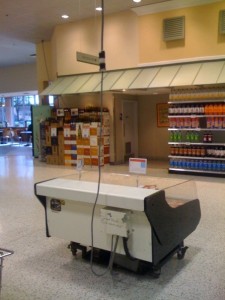 Spot the Tort isn’t just for lawyers and law students. A layperson was shocked (not literally, fortunately) to find this high-voltage electrical danger smack in the middle of an Atlanta grocery store. Spot the Tort isn’t just for lawyers and law students. A layperson was shocked (not literally, fortunately) to find this high-voltage electrical danger smack in the middle of an Atlanta grocery store.
Note to store: Your hidden warning on the back will not protect you from tort liability with regard to your “business invitee” customers. A business invitor has a duty to make the premises reasonably safe for invitees. Sometimes a warning may suffice, but only it if allows customers to negotiate the premises safely.
A lot of negligence questions are murky with no reliable answers, but I feel comfortable predicting that a judge or jury would consider placing these exposed high voltage cables in a place where children often wander freely to constitute an unreasonable risk.
 Ironically, getting close enough to read this warning actually increases the risk. Ironically, getting close enough to read this warning actually increases the risk.
December 17th, 2011 
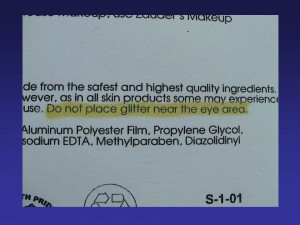
Glittery makeup is good stuff, for Halloween, your next glam band, or just for fun. And you can see how much fun this woman on the packaging is having with it. Go ahead and click on the image to expand it, so you can get the full realization of what an awesome opportunity this stuff presents to have a good time.
But wait, what’s that warning in small print on the back of the packaging?
Do not place glitter near the eye area.
December 4th, 2011  Longtime Lawhaha.com supporter Lihwei Lin sent this picture of a sticker inside a taxicab operating in the Pacific Rim. Longtime Lawhaha.com supporter Lihwei Lin sent this picture of a sticker inside a taxicab operating in the Pacific Rim.
Customers in these cabs must have been especially happy to reach their destinations. How could they not be? On entering the vehicle they are warned (italics added):
SAFETY-FIRST Please put on your seatbelt prepare for accident.
December 4th, 2011  Out and about? Thirsty? Stop. Find a convenience store or a restaurant or even a liquor store. But don’t stoop (har har) to drinking out of the toilet. In case you forget, just read the warning sticker: Out and about? Thirsty? Stop. Find a convenience store or a restaurant or even a liquor store. But don’t stoop (har har) to drinking out of the toilet. In case you forget, just read the warning sticker:
RECYCLED FLUSH WATER
UNSAFE FOR DRINKING
December 4th, 2011  This warning makes sense because a plug-in night-light is, after all an electrical device that could be dangerous. But it still sounds funny to have a warning on a Mickey Mouse product that says: This warning makes sense because a plug-in night-light is, after all an electrical device that could be dangerous. But it still sounds funny to have a warning on a Mickey Mouse product that says:
CAUTION: THIS IS NOT A TOY and is not intended for use by children.
December 4th, 2011  Here’s a great product to grow aragonite crystals just by adding white distilled vinegar. It’s hard to imagine a consumer product with greater social utility. Here’s a great product to grow aragonite crystals just by adding white distilled vinegar. It’s hard to imagine a consumer product with greater social utility.
The packaging contains a seemingly silly warning that:
WARNING: Eating rocks may lead to broken teeth!
Maybe the rocks resemble candy, in which case it wouldn’t be such a silly warning. On the other hand, anyone who would mistake the rocks for candy probably wouldn’t be old enough to read the warning.
December 4th, 2011 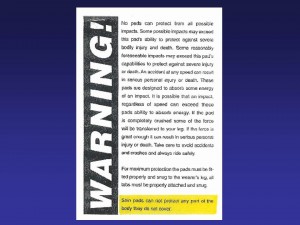 … or any other part of the body they do not cover. … or any other part of the body they do not cover.
Okay, there are unusual warnings and just plain stupid ones:
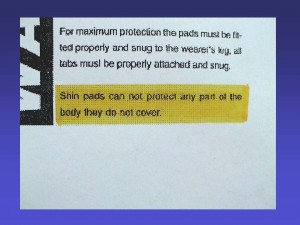 Shin pads can not protect any part of the body they do not cover. Shin pads can not protect any part of the body they do not cover.
December 4th, 2011 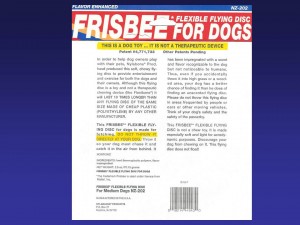 Have a dog? How’s he feeling? If he’s down in the dumps, maybe he’d enjoy a nice outdoor session chasing a Frisbee Flexible Flying Disc for Dogs. Have a dog? How’s he feeling? If he’s down in the dumps, maybe he’d enjoy a nice outdoor session chasing a Frisbee Flexible Flying Disc for Dogs.
But don’t expect it to change his mood completely by making the common consumer mistake that a plastic disc is a therapeutic device. As the manufacturer cautions across the top in all capital letters:
THIS IS A DOG TOY … IT IS NOT A THERAPEUTIC DEVICE
Lower down it warns:
DO NOT THROW IT DIRECTLY AT YOUR DOG
Why? Because he’s like to experience feelings of rejection and anxiety and require therapy, but as they just told you, it’s not a therapeutic device.
December 4th, 2011 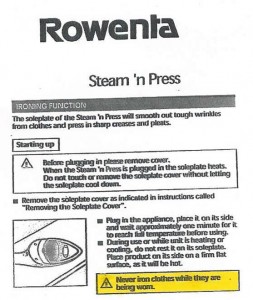 Rowenta felt the need to caution purchasers of its irons to: Rowenta felt the need to caution purchasers of its irons to:
Never iron clothes while they are being worn.
Sounds crazy, right? But when I asked my first-year law school class, filled with exceptionally intelligent people, if any of them had tried to iron clothes while wearing them, a lot of them nodded affirmatively.
December 4th, 2011  Judge Carlin LOVED this guy. A unanimous Strange Judicial Opinions Hall of Fame opinion is Cordas v. Peerless Transportation Co., penned in 1941 by Judge Carlin (no relation to George) of the New York City Court.
The defendant was a chauffeur and the victim of an armed car-jacking by a fleeing robber who threatened to blow the chauffeur’s brains out. In fright, the chauffeur slammed on the brakes and jumped out of the vehicle, which kept moving and hit the plaintiff pedestrian and her children (fortunately, injuries were slight).
The case stands for the unremarkable principle that under the basic negligence standard of reasonable care “under the circumstances,” people aren’t expected to exercise as much care in emergency situations as in non-emergencies where they have time to weigh and deliberate. It also stands as a literary masterpiece of judicial opinion writing.
Full appreciation of this classic can come only with a full reading, but here’s how it starts:
This case presents the ordinary man–that problem child of the law–in a most bizarre setting. As a lowly chauffeur in defendant’s employ he became in a trice the protagonist in a breath-bating drama with a denouement almost tragic. It appears that a man, whose identity it would be indelicate to divulge, was feloniously relieved of his portable goods by two nondescript highwaymen in an alley near 26th Street and Third Avenue, Manhattan; they induced him to relinquish his possessions by a strong argument ad hominem couched in the convincing cant of the criminal and pressed at the point of a most persuasive pistol.
Carlin apparently was a learned Shakespeare fan. In excusing the chauffeur from liability for jumping out of the moving vehicle, Carlin said:
If the philosophic Horatio and the martial companions of his watch were ‘distilled almost to jelly with the act of fear’ when they beheld ‘in the dead vast and middle of night’ the disembodied spirit of Hamlet’s father stalk majestically by ‘with a countenance more in sorrow than in anger,’ was not the chauffeur, though unacquainted with the example of these eminent men-at-arms more amply justified in his fearsome reactions when he was more palpably confronted by a thing of flesh and blood bearing in its hand an engine of destruction which depended for its lethal purpose upon the quiver of a hair.
Translation: It’s not negligent to react in fright when a carjacker has a gun pointed at your head.
— Cordas v. Peerless Transp. Co., 27 N.Y.S.2d 198, 199, 201 (City Court of N.Y. 1941). Thanks to all the folks who sent in this classic.
December 4th, 2011 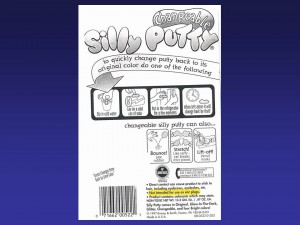 Silly Putty! What a great product. It’s may be the most successful product ever invented that lacks virtually any social utility. True, you can bend it around and pick up newsprint on it, but is it actually useful for anything? Silly Putty! What a great product. It’s may be the most successful product ever invented that lacks virtually any social utility. True, you can bend it around and pick up newsprint on it, but is it actually useful for anything?
Hey, I know, how about using it for ear plugs?
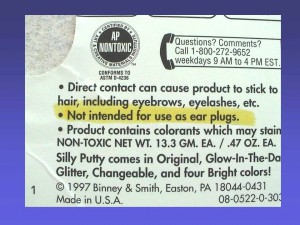 Nope, that’s no good. The packaging warns: Nope, that’s no good. The packaging warns:
Not intended for use as ear plugs.
December 4th, 2011  This warning for a Slinky is mildly amusing because Slinkys just don’t seem very dangerous, but it’s the instructions that crack me up. This warning for a Slinky is mildly amusing because Slinkys just don’t seem very dangerous, but it’s the instructions that crack me up.
First, the warning:
CAUTION: Do not use in moving vehicle. Do not throw coils out any window. Keep Slinky away from face and eyes.
Now the instructions, and pay attention because they are complicated:
TO BOUNCE SLINKY UP AND DOWN: Hold a few coils tightly in one hand, allowing rest of Slinky to hang down. Now in a bouncing motion, move hand slowly up and down.
So that’s how you do it. I never could figure that out. I was always holding it up. Duh.
December 4th, 2011  Here’s a nice wood library ladder from the Eddie Bauer Home website. It appears to be a high quality ladder, as long as you remember that it is: Here’s a nice wood library ladder from the Eddie Bauer Home website. It appears to be a high quality ladder, as long as you remember that it is:
Not for use as a ladder
December 4th, 2011 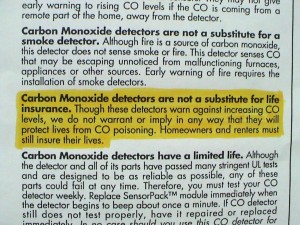 This is my favorite wacky warning of all time. Usually, if you ponder a warning, you can figure out why it’s there, even seemingly ridiculous warnings. So, for example, a warning on a heavy-duty power drill to not use it as a dental drill is probably there because some wayward consumer actually attempted to use it that way. This is my favorite wacky warning of all time. Usually, if you ponder a warning, you can figure out why it’s there, even seemingly ridiculous warnings. So, for example, a warning on a heavy-duty power drill to not use it as a dental drill is probably there because some wayward consumer actually attempted to use it that way.
But I’ve never been able to conceive of a reason–even an unreasonable fear of lawsuits-based reason–why this manufacturer of home carbon monoxide detectors felt compelled to warn purchasers that the product is not a substitute for life insurance. If you have any ideas, send them along. Here’s the warning:
Carbon Monoxide detectors are not a substitute for life insurance. Though these detectors warn against increasing CO levels, we do not warrant or imply in any way that they will protect lives from CO poisoning. Homeowners and rents must still insure their lives.
There’s another issue with this warning. Why would any consumer want to buy a carbon monoxide detector that the manufacturer is not willing to warrant, or even “imply in any way,” will protect them from CO poisoning (the advertised purpose and utility of the product).
December 4th, 2011 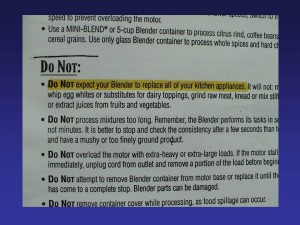 Shoot, I read this instruction on a new blender too late: Shoot, I read this instruction on a new blender too late:
DO NOT expect your Blender to replace all of your kitchen appliances.
I had already put my stove, microwave, dishwasher and fridge on Craigslist before I saw it.
December 1st, 2011
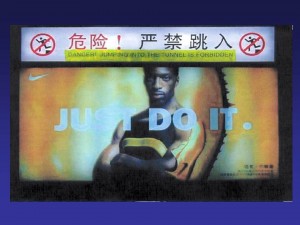 - Don’t jump in front of the train. On second thought, just do it.
A funny juxtaposition of a warning in a Hong Kong subway, directly above a Nike ad.
The translated warning at the top says (yellow highlighting):
DANGER! JUMPING INTO THE TUNNEL IS FORBIDDEN
The Nike ad below suggests one reconsider.
December 1st, 2011 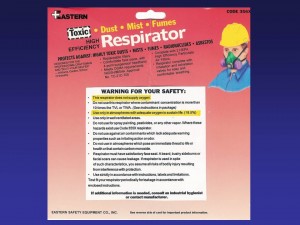 Here are the warnings from a dust-mist-fumes respirator mask from a home improvement store. It’s a good product, but just be aware that: Here are the warnings from a dust-mist-fumes respirator mask from a home improvement store. It’s a good product, but just be aware that:
This respirator does not supply oxygen.
and
Use only in atmospheres with adequate oxygen to sustain human life.
Another close call, saved by a product warning. Do not bother packing this mask for your upcoming trip through the solar system.
December 1st, 2011 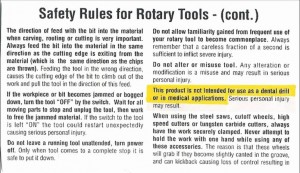 (All photos are expandable thumbnails.) (All photos are expandable thumbnails.)
Here’s a warning for a power drill, the kind you buy at Home Depot for the purpose of making holes in wood, metal and concrete.
But read up before using, people, because:
This product is not intended for use as a dental drill or in medical applications.
That last part threw me because I have this pain in my side and also this really nice 18-volt hammer drill. I was thinking, why not see what’s going on it there? I’m glad I read the warning first.
Most people enjoy this warning for the seemingly silly dental drill caution, but I also like this part:
Do not allow familiarity gained from frequent use of your rotary tool to become commonplace.
I know what they’re trying to say, and they do clear it up in the unbolded sentence that follows. It’s an issue worthy of addressing in product warnings because tons of “cognitive failure” research shows that humans are prone to mental slips when performing tasks, and, perhaps counterintuitively, that the more expert a person becomes in performing a task, the more likely he or she is to commit a mental slip. Familiarity and confidence breed inattention.
So it’s a well-intended warning, but the bolded sentence doesn’t say what it means. Essentially, it says don’t let familiarity with the tool become commonplace, which is a non-sequitur.
December 1st, 2011  In my Products Liability course, we have “Stupid Warning Day,” where each student is required to bring in an unusual warning label. When I was teaching at a law school in San Francisco, a student brought in this warning for a set of “Lock Up Your Lover Furry Handcuffs.” In my Products Liability course, we have “Stupid Warning Day,” where each student is required to bring in an unusual warning label. When I was teaching at a law school in San Francisco, a student brought in this warning for a set of “Lock Up Your Lover Furry Handcuffs.”
It’s actually a pretty good warning though:
WARNING: Place an extra key in a safe place to avoid unnecessary discomfort, embarrassment and any need to call a locksmith or a police officer.
December 1st, 2011  … 50 yards from a preschool. … 50 yards from a preschool.
University of Memphis law student Leighann Ness sent this picture of a water-filled hole a stone’s throw away from the Nashville preschool attended by her daughter.
Meanwhile, while awaiting corrective action, we can all rest easy that this ribbon of yellow tape will effectively protect nearby toddlers and others.
Leighann reported that her non-lawyer husband is the one who actually spotted the problem. As I always say, Spot the Tort is a game for the whole family.
December 1st, 2011 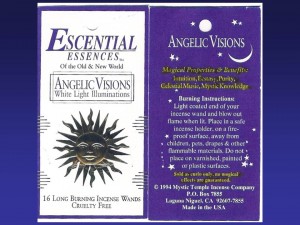 Sounds like a warning one might expect to find on one of the Weasley twins’ products in the Harry Potter franchise, but this disclaimer on a pack of incense comes from the Muggle world. Sounds like a warning one might expect to find on one of the Weasley twins’ products in the Harry Potter franchise, but this disclaimer on a pack of incense comes from the Muggle world.
 First, the incense promises a magical world of mystic knowledge and ecstasy, but the small print at the bottom takes it all back: First, the incense promises a magical world of mystic knowledge and ecstasy, but the small print at the bottom takes it all back:
Sold as curio only, no magical effects are guaranteed.
To which they might want to add:
If you’re experiencing magical effects, it’s probably not from the incense, but from that other product you’re using the incense to cover up.
November 27th, 2011  More appropriate publication vehicle than the Northeast Reporter? A lawsuit brought by a woman who got a fishbone lodged in her throat while eating a bowl of fish chowder at a Boston restaurant moved the Massachusetts Supreme Court to write an opinion devoted more to the joys of New England fish recipes than actual law.
The legal dispute is an old one: To what extent is food containing a harmful ingredient a defective product when the substance is a natural one as opposed to a foreign one?
Most modern courts apply a reasonableness test that looks at whether the substance was one a consumer would reasonably expect to find in a prepared dish, but the Massachusetts Supreme Court in this 1964 case adopted the older approach that there is no liability for harm-causing natural substances (i.e., bones as opposed to pieces of glass) in food.
Reading the opinion, it wasn’t hard to predict the defendant was going to win in the end. The court reminisced fondly about the history of fish dishes, recounted several recipes for the same, and included statements such as “we consider that the joys of life in New England include the ready availability of fresh fish chowder.”
The court went so far as to note that “[a] namesake of the plaintiff, Daniel Webster, had a recipe for fish chowder which has survived into a number of modern cookbooks and in which the removal of fish bones is not mentioned at all.”
The court concluded:
[W]e consider a dish which for many long years, if well made, has been made generally as outlined above. It is not too much to say that a person sitting down in New England to consume a good New England fish chowder embarks on a gustatory adventure which may entail the removal of some fish bones from his bowl as he proceeds. We are not inclined to tamper with age old recipes by any amendment reflecting the plaintiff’s view of the effect of the Uniform Commercial Code upon them.
This is a must-read opinion for all products liability lawyers and anyone looking for a good fish-chowder recipe.
— Webster v. Blue Ship Tea Room, Inc., 198 N.E.2d 309, 312 (Mass. 1964). Thanks to Daniel Green.
November 26th, 2011  Dangerous product? A large guy (280-90 pounds) ironically won a one-week trip to Hawaii as a reward for selling more than $20,000 in diet products. But in a lawsuit against Hanes, the underwear maker, he alleged his “dream trip” went awry due to allegedly defective briefs which “gaped open and acted like a sand belt on my privates,” causing injury.
We’ll let the court elaborate on this interesting products liability case:
Plaintiff testified that by the second day in Hawaii he was in debilitating pain. However, … he ignored the pain until he returned to Pensacola two weeks later. He explained he was able to ignore the pain because he was enjoying himself so much on this long anticipated vacation that he did not dwell on or focus on the pain to any degree.
Plaintiff testified he believed sand that he picked up in his swim trunks while enjoying the Hawaiian surf had irritated his penis. Over the next few days he and his wife “walked all over the place” until his condition worsened to the point that he “could hardly walk.” Plaintiff testified his inability to walk was caused by defendant’s defective manufacturing of his underwear which caused his “fly” to gap open. The gap resulted in his penis protruding from his underwear, whereupon the edges of the opening abraded his penis like “sandpaper belts.” …
Under cross examination plaintiff admitted he never examined his penis to assess the problem and/or treat the problem. He testified he is a “belly-man” and his “weight” prevents him from looking down and seeing his penis. He further testified he declined to use the hotel mirror to view the “injury” because that is “not something he would do.” He also testified he did not ask his wife to examine his penis because he would never ask her to do such a thing, nor would he want to let her know about his pain because it would have “ruined her vacation” as well. …
So how does one prove a complex products liability case like this one? How else? Bring on the experts! Nothing like an in-court reenactment to drive home a point (will resist the obvious “if they do not fit, you must acquit” joke):
Both the plaintiff and the defendant’s expert demonstrated the “tensions” that are placed on men’s underwear. This was done by holding the allegedly “defective” underwear and placing it under various “stresses” while comparing it with similar briefs made by other manufacturers, as well as other old, worn out Hanes brand briefs owned by plaintiff.
The uncontroverted expert testimony was that once a man’s genitalia are adjusted in his briefs, “vertical tension” is far greater than horizontal tension and there is no tendency for the fly to “gap.”
Based on the expert testimony, the judge concluded that “it was clear to the court that plaintiff’s underwear would not have ‘gaped’ open as contended by plaintiff because the tension load on men’s underwear is vertical and not horizontal.” The court speculated that it was more likely that plaintiff’s problems were caused by the “plaintiff’s manner of getting into his underwear,” which was to put them on at the same time as his pants.
The surprising legal lesson of this case is that expert testimony about tighty-whities fit can apparently pass scrutiny as scientifically valid under Daubert.
— Freed v. Hanes Brands, Inc., Case No. 2009 SC 003087 (Fla. Escambia County Ct. Oct. 12, 2009). Thanks to Cecile Mendizabel and others.
November 24th, 2011 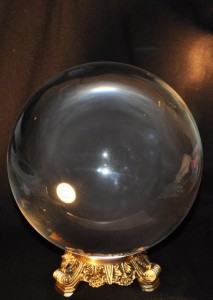 A $600,000 jury verdict for losing psychic powers sounds ridiculous, and likely the grossly misunderstood McDonald’s coffee spill case, Haimes v. Temple University has been abused as a tool to whip up on trial lawyers and the tort system. But as with the McDonald’s case, Haimes got twisted in the telling. A $600,000 jury verdict for losing psychic powers sounds ridiculous, and likely the grossly misunderstood McDonald’s coffee spill case, Haimes v. Temple University has been abused as a tool to whip up on trial lawyers and the tort system. But as with the McDonald’s case, Haimes got twisted in the telling.
Plaintiff Judith Richardson Haimes brought a medical malpractice action against defendant after a CT scan allegedly caused her chronic and disabling headaches and prevented her from practicing her occupation as a psychic. A jury awarded her $600,000 after a four-day trial.
Wow! But pro-tort reform accounts of the case omit two critical facts. First, that the trial judge specifically instructed the jury it could NOT award damages for loss of her psychic abilities, and, second, that the court threw out the plaintiff’s verdict.
Having cleared that up, the most interesting part of the case was the testimony pertaining to her psychic abilities. The plaintiff presented several police officers as witnesses who testified that plaintiffs’ psychic abilities had helped them solve cases. One special agent testified that he sought plaintiff’s advice in solving five to seven homicide cases and that information provided by plaintiff proved to be 80-90 percent accurate. The opinion describes detailed information plaintiff provided to help solve a variety of cases. It’s interesting.
— Haimes v. Temple University Hosp., 39 Pa. D. & C.3d 381 (Pa. Ct. Com. Pl. 1986). Thanks to Cynthia Cohan.
November 24th, 2011 Ohio Court of Appeals Judge Mark Painter combined humor and common sense in Gibson v. Donahue, where the plaintiff was injured being thrown from her horse, which was spooked by two Irish Setters that the defendant allowed to run free in an area restricted to equestrian use.
Talk about creative lawyering. The defendant tried to escape liability by relying on an Ohio statute intended to provide tort immunity for riding stable owners and horse show operators for injuries resulting from the inherent risks of equine activity (a statute Painter said “is noteworthy mainly for using the word ‘farrier’ ten times”).
Judge Painter observed that the case was one of first impression, “probably because no one before has been audacious enough” to try to extend the statute to a situation like this one.
Defendant did have a slim statutory leg to stand on. The statute extends immunity to “an equine activity sponsor, equine activity participant, equine professional, veterinarian, farrier, or other person.” However, Judge Painter said that for defendant’s construction to prevail, the statute would have to be read as applying to “any other person in the whole world.” Construed as defendant argued, “[a] person who negligently crashes an airplane into the crowd at an equine event would thus be immune to liability.”
By the way, a farrier is a blacksmith. Remember that if you’re a law student in Ohio. It might be on the bar exam.
— Gibson v. Donahue, 772 N.E. 2d 646, 648, 650 (Ohio Ct. App. 2002).
November 21st, 2011 Would a reasonably prudent dog batter a postal worker, negligently knock over a vase with a wagging tail or trespass on property to urinate or defecate?
Maybe we’ll find out, now that a court has held that a dog in a dog-bite case was to be judged by a “reasonable dog” standard.
In Kirkham v. Will, an Illinois intermediate appellate court held that, in deciding whether the defense of provocation applied in a dog-bite case, the appropriate test to apply was the “reasonable dog” standard; that is, how a reasonable dog would have reacted to the plaintiff’s presence under similar circumstances.
How a reasonably prudent person would have behaved under a given set of circumstances is one of the great imponderables of tort law that jurors, law students, lawyers, judges and law professors struggle with every day. Despite manifold attempts to define the standard, answers remain elusive.
We entrust the decision to jurors because they presumably know how reasonable people would act. Are they competent to determine how reasonable dogs would act? I can see it now, ads for expert witnesses in “Canine Behavior.”
— Kirkham v. Will, 724 N.E.2d 1062, 1065 (Ill. App. Ct. 2000). Thanks to Darius Asly.
November 20th, 2011  Law students learn to avoid risk, in part because of what is known as the “availability heuristic”–a mental shortcut people use to unreliably evaluate the probability of risks based on whether they can remember the event ever happening before. Law students learn to avoid risk, in part because of what is known as the “availability heuristic”–a mental shortcut people use to unreliably evaluate the probability of risks based on whether they can remember the event ever happening before.
Law students and lawyers tend to over-estimate risk because they can always imagine a situation (an availability) in every context of life where things went wrong. In all the cases they read, things went wrong, which is why they became cases. Their constant exposure to Murphy’s Law causes them to become very adept at (even obsessive about) spotting and avoiding risks in their own lives.
Here a careful student of mine studying in the law library with her laptop took the extra-prudent precaution of posting a warning sign near to the cord and plug to avoid a tripping injury risk.
November 18th, 2011 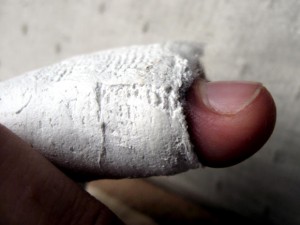 Family friendly depiction of the injury. Doe v. Moe, a May 2005 Massachusetts appellate case, gives a whole new meaning to the idea of safe sex. A guy sued his long-time girlfriend (ex-girlfriend?) for negligence when an ill-advised change in position during consensual intercourse resulted in him suffering a fractured penis. (The opinion gives details about how the accident occurred.)
In a case of first impression, the court struggled to arrive at an appropriate and workable standard of care to apply to private consensual sexual conduct. The court noted:
There are no comprehensive legal rules to regulate consensual sexual behavior, and there are not commonly accepted customs or values that determine parameters for the intensely private and widely diverse forms of such behavior.
Accordingly, the court concluded that the general negligence standard of reasonable care under the circumstances was inappropriate for consensual sex-physical injury cases.
Instead, the court said the plaintiff needed to show conduct rising to the level of “wanton or reckless.” The court opined that while the trial record might support a finding that the defendant’s conduct exposed plaintiff to a risk of harm, it did not support a finding of wanton or reckless conduct.
The case does raise an interesting legal issue. With so many different preferences and positions and idiosyncratic fantasies and fetishes, is there such a thing as a standard of “ordinary and reasonable care” for sex?
— Doe v. Moe, 827 N.E.2d 240, 245 (Mass. Ct. App. 2005). Thanks to David Keller and Professor Howard Wasserman.
November 17th, 2011  It's a dog-eat-divinity student world. A dog-bite case against the dean of the Yale Divinity School by a divinity student gave U.S. District Judge Gerard Goettel a chance to “let the dogs out” in an opinion leaving no possible wordplay on dogs unpenned or unpunned.
The main issue was whether the Yale Divinity School could be held strictly liable under the Connecticut dog-bite statute as a “keeper” of the dean’s offending canine, Rocky, a Labrador, because the dog was permitted to roam free in common areas of the divinity school residences and chapel.
The court held the dean strictly liable, but let the school off because it didn’t “control” the dog’s activities.
Here’s a compendium of Judge Goettel’s fun canine puns:
“In this dog eat dog world, anything is fair game for litigation in the federal courts.”
“As compensation for her injuries, plaintiff seeks to take a bite out of the defendants’ pocketbooks.”
“[The plaintiff], now an Episcopal priest with her own ministry, obviously has a bone to pick as her injuries required substantial medical care, and Rocky is clearly in the doghouse.”
“In dogged pursuit of damages for her trauma, she filed this suit ….”
“Hounded by Connecticut’s [dog-bite statute] ….”
“The [individual defendants] do not deny that they were keeping Rocky who apparently was not licensed to anyone but had a nose for trouble.”
“Plaintiff’s analysis is essentially the tail wagging the dog.”
“Rocky’s having access to common areas, without more evidence indicating an intent to give refuge to the dog or to control the dog’s activities on the part of the School is not a sufficient basis to collar the Divinity School.”
As for Rocky, we don’t know his fate, but the judge did offer a weak defense for the nice face-biting doggie in a footnote:
1. There is no indication that Rocky, like the dog in Oliver Goldsmith’s Elegy on the Death of a Mad Dog, “to gain some private ends, went mad and bit the [wo]man.”
— Post v. Annand, 798 F. Supp. 189, 190–91 & n.1, 192 (S.D.N.Y. 1992). Thanks to Lillian Gustilo.
November 16th, 2011  Won a defamation judgment for being called ugly. A 1996 English libel case reminds me of the old Rodney Dangerfield joke: “My psychiatrist told me I’m going crazy. I told him, ‘Doc, if you don’t mind I’d like a second opinion.’ He said, ‘Alright, you’re ugly too.’”
In Berkoff v. Burchill, an English court of appeals held that describing a person as ugly can constitute actionable defamation. No wonder people are flocking to England to take advantage of the country’s plaintiff-friendly libel laws. It’s highly doubtful calling someone ugly would be actionable defamation under U.S. law.
(By the way, this practice, known as “libel tourism,” resulted in enactment of a 2010 U.S. law that prohibits U.S. courts from enforcing foreign defamation judgments if they were rendered under legal protections less protective of speech than U.S. standards. Berkoff’s suit, against an English newspaper, was not a case of libel tourism.)
The English case arose from a Sunday Times article in which defendant Burchill reviewed the movie The Age of Innocence. Burchill described the film director, Steven Berkoff, as “hideous-looking.”
Nine months later, Burchill once again called Berkoff’s pulchritude into question, this time in a review of the movie Frankenstein. Describing “the Creature,” Burchill said: “It’s a very new look for the Creature—no bolts in the neck or flat-tap hairdo—and I think it works; it’s a lot like Stephen Berkoff, only marginally better-looking.”
Berkoff sued for defamation. The issue was whether calling someone hideous-looking is a defamatory statement capable of injuring a person’s reputation. The appellate court answered affirmatively.
The court said a jury could “conclude that in the context the remarks about Mr. Berkoff gave the impression that he was not merely physically unattractive but actually repulsive” and that this could injure Berkoff’s ability to make a living by “lowering his standing in the estimation of the public … [by] making him an object of ridicule.”
Is truth a defense? He looks okay in this picture (photo by Getty, borrowed from The Telegraph).
— Berkoff v. Burchill, [1996] 4 All E.R. 1008 (Ct. App. 1996). Thanks to Heiner O. Mommsen.
November 14th, 2011 U.S. Ninth Court of Appeals Judge Alex Kozinski is well known for sprinkling pop culture references throughout his opinions, particularly in the famous Syufy opinion, which wove in the titles of more than 200 movies. (See “Coming Soon to a Footnote Near You”)
A less noticed, but just as fun pop culture-laden opinion was his dissent to an order denying rehearing en banc in White v. Samsung Electronics America, Inc., a case where the Ninth Circuit upheld a “right of publicity” claim by former game show hostess Vanna White against Samsung for using a robot resembling her game show persona in a television commercial.
Complaining that, “[u]nder the majority’s opinion, it’s now a tort for advertisers to remind the public of a celebrity,” Kozinski excoriated the court for over-extending intellectual property rights in an opinion jammed full of pop culture references.
(That’s one thing to love about Kozinski’s writing: he can be pithy, insightful, and amusing in less than twenty words.)
Pop culture ran amuck in a single footnote (footnote 6) that includes references to (in order): grunge rocker Tad Doyle, the Hell’s Angels, Marvel Comics, Breakfast at Tiffany’s, Breakfast of Champions, The Electric Kool-Aid Acid Test, Looking for Mr. Goodbar, The Coca-Cola Kid, The Kentucky Fried Movie, Harley Davidson and the Marlboro Man, The Wonder Years, Wonder Bread, Joseph and the Amazing Technicolor Dream Coat, Janis Joplin, Paul Simon, Leonard Cohen, Bruce Springsteen, Prince, dada, Monty Python, Roy Clark, Mel Tillis, the Talking Heads, Andy Warhol, REO Speedwagon, 38 Special, Jello Biafra and the Dead Kennedys.
— White v. Samsung Elec. Am., Inc., 989 F.2d 1512, 1512 n.6, 1514 (9th Cir. 1993) (Kozinski, J., dissenting from order denying rehearing en banc). Thanks to Katherine Shipman.
November 14th, 2011 Where do scandals go when they die? They travel upwards, of course … to a U.S. Court of Appeals. At least if they’re scandals involving the saga of President Bill Clinton’s sexcapades.
U.S. Ninth Circuit Court of Appeals Judge Alex Kozinski faced an appeal in a defamation suit filed by former lounge-singer Gennifer Flowers against Hillary Rodham Clinton, James Carville and George Stephanopoulos. With that cast of characters (including Judge K), you know it’s going to be an interesting opinion.
This is an opinion to be admired as much for its lucidity as its colorful take on the events. Here’s a taste from the opening paragraphs (some paragraph breaks inserted):
Long after the public spotlight has moved on in search of fresh intrigue, the lawyers remain. And so we find ourselves adjudicating a decade-old dispute between Gennifer Flowers and what she affectionately refers to as the “Clinton smear machine”: James Carville, George Stephanopoulos and Hillary Clinton. Flowers charges that said machine destroyed her reputation by painting her as a fraud and a liar after she dis-closed her affair with Bill Clinton. We decide whether Flowers’s claims are timely and, if so, whether they survive a motion to dismiss.
Background and Proceedings Below
In the heat of the 1992 presidential primary campaign, the Star—that ubiquitous supermarket source for celebrity scandal—ran a story claiming that Bill Clinton had carried on an affair with an Arkansas woman named Gennifer Flowers. Clinton and Flowers both denied it at first, but a few days later Flowers (doubtless realizing that honesty is the best policy after all) sold her story to the Star.
Clinton continued vigorously denying the allegations and appeared on 60 Minutes with his wife to say they weren’t true. The following day, Flowers responded by holding a press conference where she played recordings of intimate phone calls from Clinton that she’d secretly taped. Later news reports suggested that the tapes may have been selectively edited.
According to Flowers, Hillary Clinton and her two “henchmen,” George Stephanopoulos and James Carville, conspired to protect Bill Clinton’s presidential candidacy from Flowers’s damaging revelations. Flowers claims that during the 1992 campaign and in later political memoirs and interviews, Carville and Stephanopoulos defamed her and painted her in a false light by claiming that she had lied in her story to the Star and “doctored” the tape-recorded phone calls.
Hillary Clinton, the alleged mastermind of the conspiracy, not only orchestrated the defamatory exploits, but also exposed private information about Flowers and organized break-ins of her residence. Flowers claims that, as a result of all this schemery, her reputation has wilted and her blossoming career as a Las Vegas lounge singer has been nipped in the bud.
It’s like the beginning of an intriguing political spy novel you want to keep reading. In the not-as-exciting climax, the Ninth Circuit panel felt compelled under the law to reverse the district court, which had dismissed all of Flowers’ claims.
Meanwhile, Kozinski gave us another Syufy-type mystery (see “Coming Soon to a Footnote Near You!”) by burying an amusing reference in one of the citations. I won’t spoil the mystery. See if you can find it.
— Flowers v. Carville, 310 F.3d 1118, 1122 (9th Cir. 2002) (Kozinski, J.). Thanks to Elise Hendrick .
November 14th, 2011  Justice Michael Musmanno, a Lawhaha.com Hall of Famer Any fan of judicial opinion writing needs to study the opinions of the Honorable Michael A. Musmanno (1897-1968). He led a remarkable life. Before joining the Pennsylvania Supreme Court, Justice Musmanno enjoyed an illustrious career as a lawyer, U.S. Congressman and author. Highlights of his career include serving as the presiding judge at the Nuremberg war crime trials and as a defense lawyer in the Sacco & Vanzetti trial.
His opinions are marvelous concoctions of deep-hearted passion and brutal common sense, delivered in highly literate and often hilarious prose.
U.S. Ninth Circuit Court of Appeals Judge Alex Kozinski, another notable opinion-writer, reported to Lawhaha.com that Musmanno has been his model since law school and that he consciously tries to emulate Musmanno’s writing. He laments that today’s law school graduates have never heard of Musmanno and return only blank stares when his name is mentioned.
Here are a couple samples of Musmanno’s writing sent by Chris Nace:
In Bosley v. Andrews, a woman sued a neighbor whose cows trespassed on her farmland to eat her crops. After being chased away in the morning, the “bovine buccaneers,” as Musmanno called them, returned for lunch. “This time they came, eight of them, with reinforcements. They brought along their boy friend, a 1500-pound Hereford white-faced bull.” The bull took chase after the plaintiff, causing her to suffer a heart attack.
A majority of the Pennsylvania Supreme Court rejected the woman’s claim for negligent infliction of emotional distress damages, following the traditional rule that such a claim cannot be maintained in the absence of a “physical impact” with the plaintiff (the bull never actually touched the plaintiff).
In dissent, Musmanno skewered the majority for what he saw as an unjust result, closing his opinion by stating that the majority’s approach “is unsupportable in law, logic, and elementary justice – and I shall continue to dissent from it until the cows come home.”
In Pennsylvania Society for the Prevention of Cruelty to Animals v. Bravo Enterprises, Inc., the plaintiff sought to enjoin a bullfight, but the majority held that the organization lacked standing. Musmanno began his impassioned dissent:
If there is one commodity of which there is no need for a further supply, it is violence. If there is one school that the world can afford to miss, it is one for the tutoring of methods of violence, brutality and cruelty. … [W]e can well do without a bullfight which is nothing less than an open air lyceum in the art of torturing helpless animals.
Add Justice Musmanno to your list of “four dead people with whom you would most like to have dinner.”
— Bosley v. Andrews, 142 A. 2d 263, 267–68, 280 (Pa. 1958) (Musmanno, J., dissenting); Pa. Soc’y for the Prevention of Cruelty to Animals v. Bravo Enterprises, Inc., 237 A. 2d 342 (Pa. 1968) (Musmanno, J., dissenting). Thanks to Chris Nace.
November 14th, 2011 In a classic slip and fall case, plaintiff Joseph Rosenberg slipped on asparagus while dancing at a wedding reception with his sister-in-law and fellow plaintiff, Ruth Schwartz.
The issue was whether the defendant caterer had negligently spilled the asparagus on the dance floor. The trial judge had dismissed the lawsuit on theory that the offending asparagus could have been unwittingly transported onto the dance floor after becoming entrapped in the apparel of the dancers.
As with many of the judicial opinions posted on Lawhaha.com, brief excerpts don’t do this case justice. My favorite part is how the legendary Justice Michael Angelo Musmanno of the Pennsylvania Supreme Court bluntly and rather contemptuously rejected the trial judge’s theory of how the asparagus (which according to testimony formed a puddle three feet in diameter) got on the dance floor (some paragraph breaks inserted):
The trial judge, an ex-veteran congressman and thus a habitue of formal parties and accordingly an expert in proper wearing apparel at such functions, all of which he announced from the bench, allowed testimony as to the raiment worn by the banquetters.
All the men were attired in tuxedos, the pants of which were not mounted with cuffs which could transport asparagus and sauce to the dance floor, unwittingly to lubricate its polished surface. Ruling out the cuffs of the tuxedo pants as transporters of the asparagus, the judge suggested the asparagus, with its accompanying sauce, could have been conveyed to the dance floor by ‘women’s apparel, on men’s coats or sleeves, or by a guest as he table hopped.’
The Judge’s conclusions are as far-fetched as going to Holland for hollandaise sauce. There was no evidence in the case that anybody table hopped; it is absurd to assume that a man’s coat or sleeve could scoop up enough asparagus and sauce to inundate a dance floor to the extent of a three-foot circumference; and it is bizarre to conjecture that a woman’s dress without pockets and without excessive material could latch on to such a quantity of asparagus, carry it 20 feet (the distance from the tables to the dance floor) and still have enough dangling to her habiliments to cover the floor to such a depth as to fell a 185 pound gentleman with 35 years’ dancing experience who had never before been tackled or grounded while shuffling the light fantastic.
…
It can be stated as an incontrovertible legal proposition that anyone attending a dinner dance has the inalienable right to expect that, if asparagus is to be served, it will be served on the dinner table and not on the dance floor.
…
Judgment reversed with a procedendo.
Chief Justice Bell dissented:
One cannot help wondering if plaintiffs had, in the alleged 35 years of dancing, ever been to any dance, let alone a wedding banquet dance. … A dancer cannot, with legal sanction, look only into the captivating eyes of his lovely partner.
I certainly dissent.
— Schwartz v. Warwick-Philadelphia Corp., 226 A.2d 484, 485–87, 488 (Pa. 1967). Thanks to Janet Heydt.
November 7th, 2011  Thanks to Duncan Young, a childhood friend from back in South Florida, for this pic of a dangerous pedestrian/jogger/pet/bike rider/car-absorbing death-trap on a Ft. Lauderdale street where the grate is missing. Thanks to Duncan Young, a childhood friend from back in South Florida, for this pic of a dangerous pedestrian/jogger/pet/bike rider/car-absorbing death-trap on a Ft. Lauderdale street where the grate is missing.
As a good citizen (and police chief of a neighboring community), he reported it. The next time he drove by a new grate had been installed.
No way to know whether the quick corrective action occurred because: (1) Duncan is a police chief of a neighboring community; (2) the city has genuine concern for its citizens; or (3) the city has genuine concerns about being sued.
November 1st, 2011  Professor Jonathan Turley exposed phony outlandish tort cases. Although several years old, Professor Jonathan Turley’s USA Today article exposing phony tort cases remains must-reading for anyone concerned about the tort reform movement. Why? Because people are still circulating these tall tales.
You know those crazy tort lawsuits you read about, the ones that make people indignant about the tort sytem, the ones politicians and tort reformers use to build public support for the movement, the ones that get endlessly forwarded to email inboxes?
They’re crazy, to be sure. But, one problem. A lot of the most notorious cases are fabricated, as Turley explored in his article.
The notorious–but apparently fictitious winning-plaintiffs–and their outlandish “cases” include:
• Kathleen Robertson, a woman who–imagine this–received a $780,000 jury award against a furniture store after she tripped over her own son.
• Carl Truman, who won a $74,000 judgment after his hand was run over by a neighbor. The neighbor could not see Truman because he was kneeling down while in the process of stealing the neighbor’s hubcaps.
• Terrence Dickson of Bristol, Pa., a man who received a $500,000 award against a garage-door manufacturer after he almost starved while trapped in the garage of a house he was burglarizing while the family was on vacation.
• And my personal favorite, a Mr. Grazinski, who won more than $1,750,000 against Winnebago when the RV he was driving went off the road after he put it on cruise control at 70 mph to go into the back to fix a cup of coffee.
Turley was unable to track down records showing that any of these, or several other notorious crazy lawsuits, actually existed.
It should be more than a little troubling to people that state legislatures have passed thousands of tort reform statutes throwing out 200 years of carefully considered common law (judge-made law) in part based on sound-bite reporting of cases that never happened.
— Jonathan Turley, Legal Myths: Hardly the Whole Truth, USA Today, Jan. 30, 2005.
October 31st, 2011  The intersection of church and tort law is an interesting area. For the most part, courts–wisely so–have been reluctant to entangle tort law with church and religion except in cases of intentional physical batteries. In Bass v. Aetna Ins. Co., the court had to decide whether “trotting under the Spirit of the Lord” in church, with the result of running into and injuring the plaintiff, was actionable or a protected “Act of God.” The intersection of church and tort law is an interesting area. For the most part, courts–wisely so–have been reluctant to entangle tort law with church and religion except in cases of intentional physical batteries. In Bass v. Aetna Ins. Co., the court had to decide whether “trotting under the Spirit of the Lord” in church, with the result of running into and injuring the plaintiff, was actionable or a protected “Act of God.”
Plaintiff attended the Shepard’s Fold Church in Louisiana, where moving or running in the aisles “in the Spirit” apparently is a common practice. During a revival, a fellow worshiper ran down the aisle where plaintiff was kneeling and praying and knocked her down, causing injury. Plaintiff sued for negligence.
At trial, the defendant testified he was “‘trotting’ under the Spirit of the Lord” and was not in control of his actions at the time of the collision. He raised “Act of God” as a defense and also asserted the plaintiff assumed the risk of the collision and was contributorily negligent. For non-legals, an Act of God under law is a harm-causing force of nature, such as a tornado or flood, the consequences of which humans generally are not held responsible for.
The trial court dismissed the case, finding that the plaintiff assumed the risk of the collision by praying in the aisle with her eyes closed, a decision affirmed by the court of appeals. But the Louisiana Supreme Court reversed.
The West headnote writers summed up the holdings succinctly:
[1] Negligence: Notwithstanding that worshiper testified he was trotting under the Spirit of the Lord, “Act of God” defense did not apply in action by worshiper who was injured while praying in the aisle against second worshiper who was running in church inasmuch as “Act of God” meant force majeure.
[14] Religious Societies: It is not contributory negligence to bow one’s head while praying in church, whether in the pew or in the aisle.
— Bass v. Aetna Ins. Co., 370 So. 2d 511 (La. 1979). Thanks to a fellow Torts professor.
October 23rd, 2011 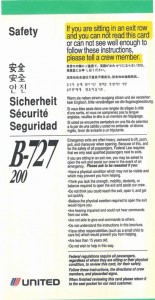 One of my favorite types of silly warnings is the kind that can’t possibly be followed. This is a great example, “borrowed” from the seat-back pocket of Boeing B-727 airliner: One of my favorite types of silly warnings is the kind that can’t possibly be followed. This is a great example, “borrowed” from the seat-back pocket of Boeing B-727 airliner:
If you are sitting in an exit row and you can not read this card, … please tell a crew member.
Alrighty.
Imagine what airlines would write if they really thought we couldn’t read any of it:
“Meanwhile, while you’re sitting there unable to read this card hoping we’ll come by with the drink cart before you pass out, let us tell you how much we enjoy treating you like cattle, bossing you around, losing your luggage, starving you into submission, and, when we can, smashing your heads against the overhead compartment, accidental like. Customer service? Ha, haa. That’s a good one. Too bad you can’t read this, SUCKERS!”
October 20th, 2011 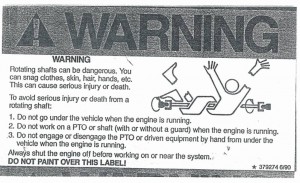 Much products liability litigation is directed at whether a product warning was reasonably clear in explaining the actual risk of the product. A subsidiary argument involves pictorial warnings. Pictorial warnings have the benefit of being understood by persons who read in different languages or who are illiterate. Their downside is that they often are unclear because it is difficult to capture most product warnings in a simple picture or symbol. Much products liability litigation is directed at whether a product warning was reasonably clear in explaining the actual risk of the product. A subsidiary argument involves pictorial warnings. Pictorial warnings have the benefit of being understood by persons who read in different languages or who are illiterate. Their downside is that they often are unclear because it is difficult to capture most product warnings in a simple picture or symbol.
But I think everyone would agree that the graphic pictorial warning on this vehicle with a rotating-shaft device clearly indicates this is a risk a reasonable person would avoid.
October 16th, 2011 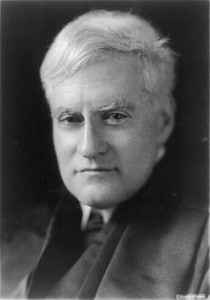 Cardozo wrote the famous majority opinion in Palsgraf. Several lawhaha visitors sent in Mark Fass’s article in the New York Law Journal about an alleged curse on the family of Helen Palsgraf, the most famous torts plaintiff in history. Every lawyer remembers Mrs. P from law school. To test this theory, visit an elderly, dying lawyer in a coma and shout “Palsgraf!” Immediately, he will recite: “A man carrying a box wrapped in newspaper boarded a train at the Long Island Railroad Station … cough, cough … ack.”
The box contained fireworks. When it was dislodged by employees of the Long Island Railroad trying to help the man on the train, the fireworks exploded, allegedly knocking a scale onto Mrs. P. Mrs. P’s saga led to the legendary, and incredibly confusing, opinions by Judge Benjamin Cardozo (that’s Cardozo in the picture–handsome fellow he was) and Judge William Andrews studied by students year in and year out at law schools great and small.
Now Fass reports that Mrs. P’s accident began a curse on the Palsgraf family, at least that’s what some of her descendants believe. One descendant fell off a ladder in 1965 and sued the manufacturer, but never made it to trial because the ladder was stolen. Another lost her thumb when a ping-pong table collapsed. A lawsuit led to a small settlement. Another descendent tripped while jogging over a broken curb, but was discouraged by lawyers from filing suit.
The most intriguing Palsfraf mishap reported by Fass involves a descendant who lost control of his truck on an icy hill in 1968. The truck slid towards the edge of cliff. Guess what saved the life of Mrs. P’s closest living relative? The truck’s wheels got caught on a track of … you guessed it, the Long Island Railroad. (Cue Twilight Zone theme.)
— Mark Fass, Palsgraf Railroad Injury Proximate Cause of Family Curse?, New York Law Journal, Dec. 10, 2004.
October 16th, 2011  As a Torts prof, I loved this tidbit sent in by Elise Hendrick. Good old Mrs. Palsgraf. You can try, but you can’t keep her down. As a Torts prof, I loved this tidbit sent in by Elise Hendrick. Good old Mrs. Palsgraf. You can try, but you can’t keep her down.
Elise was listening to oral arguments before the U.S. Supreme Court in Exxon Co. USA v. Sofec, 116 S.Ct. 1813 (1996), and came across the following exchange between George Playdon, counsel for Sofec, and Justice Scalia. The two were engaged in a colloquy about the maritime supervening cause doctrine:
Scalia: I’m not sure that you need a “doctrine of supervening cause.” Is a doctrine of supervening cause anything other than Palsgraf? When you say, you know, that the negligence … the causality … had long since terminated. Once you say you’re out of the scope of the risk, what do you need a doctrine of supervening cause for? And isn’t that basically your case?
Playdon (chuckling): I smile—I never envisioned thirty years ago that I’d have the opportunity …
Scalia: Of arguing Palsgraf!
Playdon (stammering, laughing): Obviously, Palsgraf is a foreseeability doctrine, just like Hadley v. Baxendale is a foreseeability problem.
Elise speculates that this may have been the first time the implausible case of Mrs. P has been mentioned in court since Palsgraf was decided in 1928.
— Thanks to Elise Hendrick.
October 15th, 2011 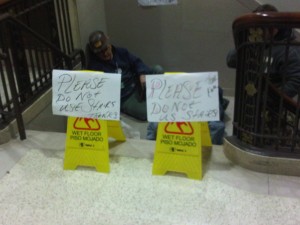 Just one question: Is it okay to use the stairs? Just one question: Is it okay to use the stairs?
Not surprisingly, since they are full of law professors and law students, law schools are pretty safe places. Be hard to overlook these warnings at the University of Memphis law school.
Wait, what is that in the background? Looks like a dead body. Maybe just a tired 1L.
October 15th, 2011  Poopi the poodle and her owners sued their veterinarian after Poopi underwent anesthesia for teeth cleaning and woke up with a three-inch scar on her abdomen. The vet mistakenly tried to spay Poopi, even though she had already been spayed as a puppy. Poopi the poodle and her owners sued their veterinarian after Poopi underwent anesthesia for teeth cleaning and woke up with a three-inch scar on her abdomen. The vet mistakenly tried to spay Poopi, even though she had already been spayed as a puppy.
Poopi’s owners sought emotional distress damages for themselves as well as for Poopi, including expenses for Poopi’s psychological care. Plaintiffs conceded that under Ohio law dogs are considered to be personal property, but argued that the court should “do the right thing” by distinguishing pets from inanimate objects. They quoted from a law review article that equated the death of a “companion animal” to “the wrongful killing of any other family member.”
The Ohio Court of Appeals affirmed the trial judge, which had rejected the claim, although one member of the appellate panel concurred “reluctantly” and suggested that the legislature consider allowing damages for tortious injuries to pets.
Now that the suit has been wrapped up, perhaps Poopi should consult independent counsel about the possibility of pursuing emotional distress of having to go through life named “Poopi.”
— Oberschlake v. Veterinary Assoc. Animal Hosp., 785 N.E.2d 811 (Ohio Ct. App. 2003).
October 15th, 2011 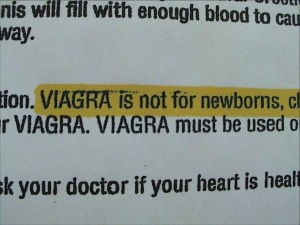 From what I hear, Viagra is a high-quality product, but like all prescription products, it’s not for everyone. Specifically, Viagra is NOT FOR NEWBORNS. From what I hear, Viagra is a high-quality product, but like all prescription products, it’s not for everyone. Specifically, Viagra is NOT FOR NEWBORNS.
This is the kind of warning people read and think “Those crazy [fill in the blank: lawyers, consumers, manufacturers …].” Who needs to be told that Viagra is not for newborns?
Healthcare providers. That’s right. Turns out that sildenafil, the active ingredient in Viagra, has been found to be useful in preventing “rebound pulmonary hypertension” in infants.
But since it’s not FDA-approved for such a use, one can understand why Pfizer, the manufacturer, might feel a need to warn against this foreseeable use or misuse of the product.
(Since I posted this, I found out my 93-year-old mom is feeding Viagra to her female dog on her veterinarian’s instructions for some kind of pulmonary condition. This comes out in a phone conversation where the topic thread started like this: “Have you heard about this product they have for … oh, what’s it called? I forget, but it’s for men so they can keep having sex forever.” “Uh, yeah, mom, I’ve heard of it.”)
October 12th, 2011 • Warnings and Instructions
• Spot the Tort
• Interesting Tort Cases
Tortland is an odyssey into that great body of mishaps, missteps, misdeeds, slips, falls, spills, chills, thrills, botched operations, vicious dogs, tainted food, falling ladders, collapsing reservoirs, defective products, slander, libel, and pain and suffering that collectively make up one of the world’s most controversial and certainly most interesting adjudicatory mechanisms: the American tort system.
 I got the nickname Tortman way back in the day. Walking past a group of students, one of them looked up and said, “Yo, Tortman, whazzup?” For some reason, the nickname stuck. I got the nickname Tortman way back in the day. Walking past a group of students, one of them looked up and said, “Yo, Tortman, whazzup?” For some reason, the nickname stuck.
In most cases, there’s nothing at all funny about real tort cases because they involve people who were injured or even killed. (See blog post about humanizing torts.) But it’s that same human element–combined with some very unusual fact patterns–that makes tort law so fascinating.
Spot the Tort — Making the World Safer One Tort at a Time
 My kid’s nickname is Tortgirl because—no kidding—one of her favorite games when she was a child was “Spot the Tort.” It worked like this: We’d be sitting in a public place and I’d say, “Tortgirl, spot the tort!” Then I’d time her as she ran around trying to identify the nearest defective premises condition. Sound sick? Probably, but I’ve taught thousands of first-year law students to play Spot the Tort over the years and they’ve lived happier and healthier lives because of it. My kid’s nickname is Tortgirl because—no kidding—one of her favorite games when she was a child was “Spot the Tort.” It worked like this: We’d be sitting in a public place and I’d say, “Tortgirl, spot the tort!” Then I’d time her as she ran around trying to identify the nearest defective premises condition. Sound sick? Probably, but I’ve taught thousands of first-year law students to play Spot the Tort over the years and they’ve lived happier and healthier lives because of it.
Send in pictures of potential torts you spot out there in Tortland. The moment you start paying attention, you’ll realize tortious risks are everywhere. (Technically, Spot the Tort is really Spot the Risk because a completed tort doesn’t occur until someone is injured by the dangerous condition.) You don’t have to be a lawyer to spot a potential tort, which can be defined in this context as any observable physical condition that looks “unreasonably dangerous.”*
* For the non-legally inclined, an “unreasonable danger” is one where the burden of eliminating the danger (such as the cost of fixing a hole in the sidewalk) is less than the probability of the danger resulting in injury multiplied by the potential severity of the injury–that is, how likely is it someone will step in the hole and how badly could they be hurt?
Product or activity warning labels and instructions can provide great entertainment. Seriously. If you are bored, dig out some instruction booklets for products you own. It will be a good time, I promise. I even tell my students to take their dates to Walmart on a Saturday night for a fun night of strolling the aisles reading product warning labels. At least one student took me up on the idea.
Send in any funny or interesting warnings or instructions you come across. Use the Contact link at the top of any site page, which allows for attachments.
In the meantime, here are three things most people don’t understand about “wacky” product warning labels:
Three Things Everyone Should Know About Product Warning and the Law
(1) Product makers do not owe a legal duty to warn of obvious dangers, but often warn of them anyway to protect themselves. After all, extra warnings don’t cost much to include and who knows what a jury might conclude in hindsight was or was not an obvious danger? Unfortunately, there is an intangible cost to unnecessary warnings, which is that they dilute the impact of important warnings that people need to pay attention to.
(2) Some warnings that sound wacky are included because consumers have in fact misused the product in exactly that way. Take, for example, this warning on a blow dryer-type hair dryer:
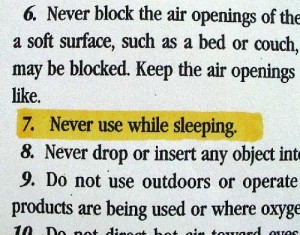
What the heck? What moron would use a hair dryer while sleeping? It turns out some consumers use blow dryers to keep their beds warm on winter nights.
(3) Some warnings that sound crazy are, in fact, good warnings that provide information about product risks unknown to reasonable consumers. As Exhibit A, I offer this warning from a set of non-stick cookware, one of my all-time favs (click to expand the pic):
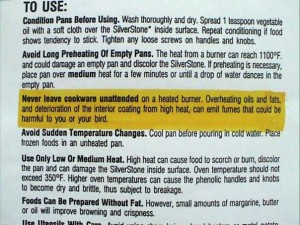
Harm to “you or your bird”? An unusual warning to be sure, but the non-stick cookware coating polytetrafluorethylene, which is used in Teflon® and a number of similar products, apparently omits fumes when overheated that can kill birds. If you have a bird, you’d definitely want to know that.
Enjoy Lawhaha’s collection of warning label and instructions.
Tort law has produced more than its share of classic cases, often known and remembered because of the unusual circumstances befalling ordinary people. These classics range from a five-year-old boy being sued for battery for pulling a chair out from under an elderly woman (Garratt v. Dailey) to Helen Palsgraf’s fateful afternoon at the Long Island train station in 1920 (Palsgraf v. Long Island R.R. Co.). Interesting Tort Cases includes tort cases both old and new, serious and amusing. Please send along any particularly interesting tort cases you come across. Use the Contact link at the top of any site page.
|
Funny Law School Stories
For all its terror and tedium, law school can be a hilarious place. Everyone has a funny law school story. What’s your story?
|
Product Warning Labels
A variety of warning labels, some good, some silly and some just really odd. If you come encounter a funny or interesting product warning label, please send it along.
|
Tortland

Tortland collects interesting tort cases, warning labels, and photos of potential torts. Raise risk awareness. Play "Spot the Tort." |
Weird Patents
Think it’s really hard to get a patent? Think again.
|
Legal Oddities
From the simply curious to the downright bizarre, a collection of amusing law-related artifacts.
|
Spot the Tort
Have fun and make the world a safer place. Send in pictures of dangerous conditions you stumble upon (figuratively only, we hope) out there in Tortland.
|
Legal Education
Collecting any and all amusing tidbits related to legal education.
|
Harmless Error
McClurg's twisted legal humor column ran for more than four years
in the American Bar Association Journal.
|
|
|
 Are you in law school? Do you consider yourself to be a dedicated law student? Not sure? Measure yourself on McClurg’s simple 0-100 scale, with 0 being “I’m not totally thrilled with Judge Learned Hand” and 100 being “I aspire to be like the guy in this picture.”
Are you in law school? Do you consider yourself to be a dedicated law student? Not sure? Measure yourself on McClurg’s simple 0-100 scale, with 0 being “I’m not totally thrilled with Judge Learned Hand” and 100 being “I aspire to be like the guy in this picture.”

























































































